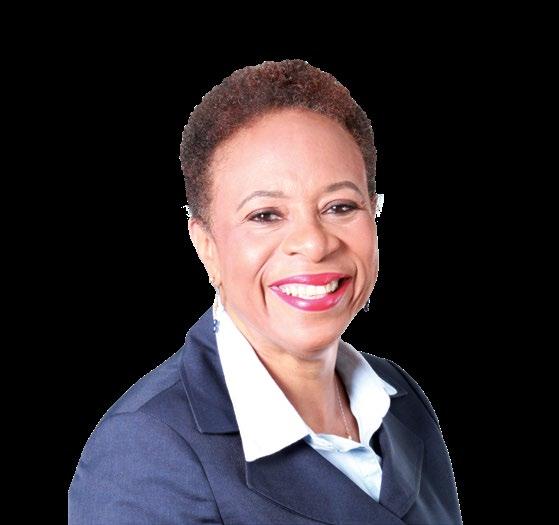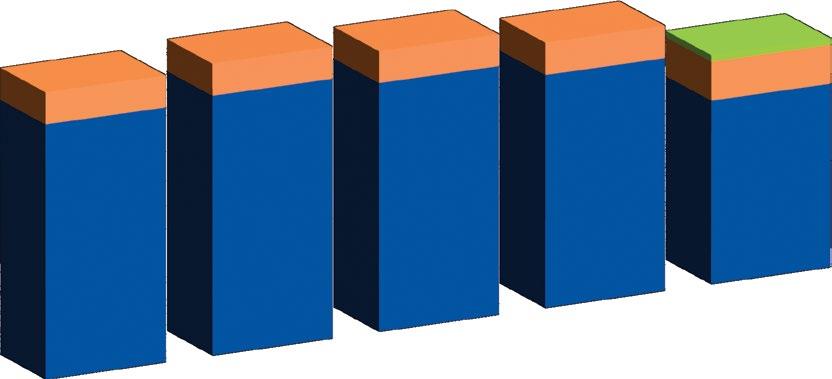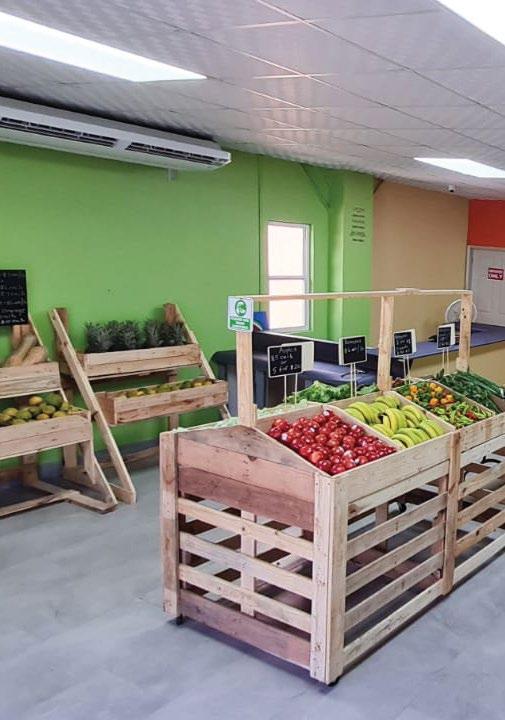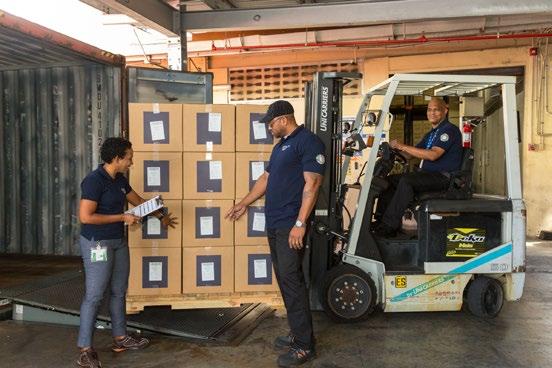
BUILDING A BETTER




Ingrid Lashley, Chairman
Raoul Glynn, Managing Director
Danielle Chow
John De Silva
Andres Lorenzo
Andrea Martini
Juan Carlos Restrepo Piedrahita
Isha Reuben-Theodore
Arturo Rodriguez Lordmendez
John De Silva, Chairman
Ingrid Lashley
Danielle Chow
Andrea Martini
Kathryn Abdulla, Company Secretary
Rowan Brathwaite, Asst. Company Secretary
Corner Eastern Main Road & Mount D’Or Road
Champs Fleurs
Republic of Trinidad and Tobago
Telephone No. (868) 662-2271/2
Facsimile No. (868) 663-5451
Email: west indian tobacco@bat.com
Website: www.westindiantobacco.com
Trinidad & Tobago Central Depository
10th Floor Nicholas Tower
63-65 Independence Square Port of Spain
Republic of Trinidad and Tobago
Telephone No. (868) 625-5107
Facsimile No. (868) 623-0089
Email: lsamai@stockex.co.tt
Fitzwilliam, Stone, Furness-Smith & Morgan
48-50 Sackville Street
Port of Spain
Republic of Trinidad and Tobago
Telephone No. (868) 623-1618
Facsimile No. (868) 623-6524
Email: fitzstone@fitzwilliamstone.com
M. Hamel-Smith & Company
Eleven Albion
Corner Dere and Albion Streets
Port of Spain
Republic of Trinidad and Tobago
Telephone No. (868) 299-0981
Facsimile No. (868) 625-9177
Email: mhs@trinidadlaw.com
KPMG
11 Queen’s Park East
Port of Spain
Republic of Trinidad and Tobago
Telephone No. (868) 623-1081
Email: kpmg@kpmg.co.tt
Citibank (Trinidad & Tobago) Limited
12 Queen’s Park East
Port of Spain
Republic of Trinidad and Tobago
Republic Bank Limited
59 Independence Square
Port of Spain
Republic of Trinidad and Tobago
Scotiabank Trinidad and Tobago Limited
56-58 Richmond Street
Port of Spain
Republic of Trinidad and Tobago

To sustain our market leadership in Trinidad and Tobago and to be the number one manufacturing centre in the Caribbean.















We are BOLD



We dream big and share innovative ideas. We make tough decisions quickly and are proudly held accountable for them.

forms the core of our culture and guides how we deliver our strategy.

We are FAST


We are resilient and fearless in beating the competition. Speed matters. We set a clear direction and move fast. We keep it simple and focus on outcomes. We learn quickly and share learnings.
We are EMPOWERED
We are RESPONSIBLE
We set the context for our teams and trust their expertise. We challenge each other. Once in agreement, we commit collectively. We collaborate and hold each other accountable to deliver.
We value different perspectives. We build on each other’s ideas, knowledge and experiences. We challenge ourselves to be open-minded and to recognise unconscious bias.

We are DIVERSE We take action to reduce the health impact of our business. We ensure the best quality products for our consumers, the best place to work for our people and the best results for our shareholders. We act with integrity, never compromising our standards and ethics.
Notice is hereby given that the ONE HUNDRED AND EIGHTEENTH ANNUAL MEETING of SHAREHOLDERS of THE WEST INDIAN TOBACCO COMPANY LIMITED (“the Company”) will be held at the Queen’s Hall, 1-3 St Ann’s Road, Port of Spain, Trinidad on Tuesday 25 April 2023 at 10:00am for the following purposes:
1. To receive and consider the Audited Financial Statements of the Company for the financial year ended 31 December 2022, together with the Reports of the Directors and Auditors thereon.
2. To declare a Final Dividend for the financial year ended 31 December 2022.
3. To re-elect Mr Juan Carlos Restrepo Piedrahita who retires in accordance with paragraph 4.7:5 of Bye-Law No. 1 of the Company, as a Director of the Company in accordance with paragraph 4.7:7 of Bye-Law No. 1 for a term from the date of his election until the close of the third Annual Meeting of the Company following his election or until his retirement in accordance with paragraph 4.7:5.
4. To re-elect Mr John De Silva who retires in accordance with paragraph 4.7:5 of Bye-Law No. 1 of the Company, as a Director of the Company in accordance with paragraph 4.7:7 of Bye-Law No. 1 for a term from the date of his election until the close of the third Annual Meeting of the Company following his election or until his retirement in accordance with paragraph 4.7:5.
5. To re-elect Mr Arturo Rodriguez Lordmendez who retires in accordance with paragraph 4.7:5 of ByeLaw No. 1 of the Company, as a Director of the Company in accordance with paragraph 4.7:7 of ByeLaw No. 1 for a term from the date of his election until the close of the third Annual Meeting of the Company following his election or until his retirement in accordance with paragraph 4.7:5.
6. To re-elect Ms Ingrid Lashley who retires in accordance with paragraph 4.7:2(g) of Bye-Law No. 1 of the Company, as a Director of the Company in accordance with paragraph 4.7:10 of Bye-Law No.1 for a term from the date of her election until the close of the next Annual Meeting.
7. To elect Mr Andres Lorenzo as a Director of the Company in accordance with paragraph 4.3 of ByeLaw No. 1 of the Company for a term from the date of his election until the close of the third Annual Meeting of the Company following his election or until his retirement in accordance with paragraph 4.7:5.
8. To elect Mr Raoul Glynn as a Director of the Company in accordance with paragraph 4.3 of Bye-Law No. 1 of the Company for a term from the date of his election until the close of the third Annual Meeting of the Company following his election or until his retirement in accordance with paragraph 4.7:5.
9. To reappoint Messrs KPMG as Auditors of the Company to hold office until the close of the next Annual Meeting.
10. To transact any other business as may properly be brought before the meeting.
BY ORDER OF THE BOARDKathryn
AbdullaCompany
SecretaryCorner Eastern Main Road and Mount D’Or Road
Champs Fleurs TRINIDAD
14 March 2023

1 No material service contracts were entered into between the Company and any of its Directors.
2. The Directors of the Company have not fixed a record date for the determination of shareholders who are entitled to receive notice of the Annual Meeting. In accordance with Section 111(a)(i) of the Companies Act, Ch. 81:01 the statutory record date applies. Only shareholders on record at the close of business on Monday 13 March 2023, the date immediately preceding the date on which the Notice is given, are therefore entitled to receive Notice of the Annual Meeting.
3. A shareholder entitled to attend and vote at the Annual Meeting is entitled to appoint a proxy or one or more alternate proxies to attend and act at the Meeting in the manner and to the extent authorised by the proxy and with the authority conferred by the proxy. A proxy need not be a shareholder. All Proxy Forms should be completed and deposited with the Secretary of the Company at the Registered Office of the Company at least 48 hours before the time appointed for the Annual Meeting.
4. A shareholder who is a body corporate, may, in lieu of appointing a proxy, authorise an individual by resolution of its directors or governing body to represent it at the Annual Meeting.

2022 marked the culmination of WITCO’S TT$85 million investment in the Company’s assets and personnel – evidence of the unyielding confidence in the potential of the industry and our unwavering commitment to our operations in Trinidad and Tobago. Our legacy as a leading manufacturer locally and throughout the Caribbean will continue to anchor our future.
The Company recorded a Profit Before Taxation of $379 million for the year ended 31 December 2022, representing a decline of $158 million or 30% over the corresponding period. Profit for the Year was $262 million reflecting a decline of $117 million or 31% less than 2021.
The year started with optimism as the Government continued the gradual removal of COVID-19 restrictions which facilitated increased social activity. This was confirmed with the re-opening of the entertainment channels and a moderate return of carnival activities as showcased by the “Taste of Carnival” celebrations. The local economic outlook for 2022 was underpinned by continued efforts to diversify the economy with a focus on manufacturing and the non-energy sector. According to the Central Statistical Office (CSO), the non-energy sector recorded strong
economic growth of 7.5% in the first half of 2022, demonstrating the success of these efforts.
Growth in Latin America and the Caribbean was forecasted at 3.5% in 2022, reflecting strongerthan-expected activity in the first half of 2022 buoyed by favourable commodity prices and the normalization of activities in contact-intensive sectors such as tourism and entertainment. However, Inflation would surface as an emerging challenge in the Caribbean, and this was evidenced by its impact on real income and the purchasing power of citizens. These socioeconomic challenges continue to put pressure on our consumers and the market leading to increased demand for lower-priced tobacco products as well as in other categories while also contributing to the burgeoning of the illicit trade.
We successfully employed strategies during the year in our drive for continued agility and maintenance of a sustainable business model. These included accelerating the introduction of new product offers to respond to changing consumer demands, transforming our portfolio, and leveraging our best-in-class distribution system to ensure uninterrupted delivery of our products to customers. Recognizing the changes
in consumer dynamics, we continued to leverage the benefits of a diverse portfolio which covers the entire spectrum of consumer demand. We were able to achieve significant growth in the lowpriced category (Rothmans), while maintaining market share in the ‘value for money’ (Lucky Strike White) and aspirational (Lucky Strike Red) categories and witnessed notable resilience in the premium (Dunhill) segment. We are proud to have been able to accomplish this amid COVID-19 restrictions, supply chain disruption, and a challenging economic environment.
We remain committed to supporting the Government’s drive to protect local manufacturing and the livelihood of those legitimately involved in our industry. As part of our Environment, Social and Governance (ESG) strategy, we continued to ensure that our business had a positive impact on our consumers and our country. This is evidenced by our ongoing adherence to good business practice, world class products, stakeholder engagement, and commitment to deliver value for our shareholders. We are also proud of our continued efforts to drive sustainability initiatives across the business which include recycling, energy efficiency, water conservation, world class health & safety standards as well as employee development programmes.
At WITCO, we take great pride in our enduring commitment to fostering the rich cultural heritage of Trinidad and Tobago through our longstanding partnership with the Steelpan, the national instrument of the country. As a responsible corporate entity, we have remained dedicated to supporting the growth of the communities in which we operate and its cultural practices. To this end, we have actively engaged with the distinguished 12-time National Panorama champions, demonstrating our unwavering support for the development of this iconic musical art form.

During the period, Board Members Diana Hernandez Gonzalez and Laurent Meffre
(Managing Director) resigned to pursue new career opportunities. We wish to express our gratitude to these Directors for their invaluable contribution and stewardship during this period. At the same time, we welcomed Andres Lorenzo and Raoul Glynn, the latter who, with effect from October 2022, assumed the role of Managing Director. Mr. Glynn is a remarkable home-grown talent with significant local, regional, and global experience, and we are confident in his ability to lead the company towards "A Better Tomorrow"TM. Directors have recommended a final dividend of $0.26 per ordinary share and this, once approved by shareholders and added to the dividend of $0.72 per ordinary share already paid in 2022, will provide for an overall dividend payment of $0.98 per ordinary share for 2022. Based on the share price as at 31 December 2022, this maintains a dividend yield of 4.5%. This dividend will be paid on 25 May 2023 to shareholders of record at the close of business on 08 May 2023. The Register of Shareholders will be closed on 09 and 10 May 2023 for the processing of transfers.
We take pleasure in celebrating the 118-year milestone of our company's legacy and strength. We are truly grateful to all stakeholders for their ongoing support during this year. We are particularly appreciative of our customers who have placed their faith in us, our employees who have worked tirelessly to accomplish our shared objectives, and the Government of Trinidad and Tobago for creating a beneficial business climate. With investment in capital, community, and human resource assets, we are confident that WITCO will continue to be a key driver of the socio-economic progress of Trinidad and Tobago in 2023.
INGRID LASHLEY ChairmanThe growth outlook for 2023 is expected to be positive as oil, gas, and petrochemical prices are anticipated to be higher than pre-pandemic levels. The current Government, however, will remain prudent with relatively restrained spending, notwithstanding higher projected energy revenues. Consequently, the fiscal deficit should narrow in the 2022/23 fiscal year with public debt continuing a gradual downward trajectory. However, economic recovery and growth is not without risks as global energy markets will continue to exhibit high levels of volatility in 2023.
2022 remained a challenging year for the manufacturing sector and the overall economy despite the lifting of COVID 19 restrictive measures. The Government maintained its commitment to creating an environment in which the manufacturing sector continues to play a role in driving economic growth and export diversification on the road to economic recovery. The Government continues to face several challenges such as foreign exchange shortage, food security and crime which threatens economic stability and the rate of economic recovery.
Businesses continue to struggle with post pandemic challenges and will have to recalibrate going into 2023 due to the impact of global recession, unstable oil and gas prices and widespread disruption in the global supply chain. The Trinidad and Tobago economy is faced with the task of maintaining economic stability in a volatile and uncertain environment

It is against this background that the Honorable Finance Minister delivered his eighth national budget presentation under the theme “Tenacity and Stability in the face of Global Challenges”. The budget is based on an estimated oil price of US $92.50 per barrel and gas price of US$6 per MMBtu. The total revenue estimated is TT$56.175B while total estimated expenses is TT$57.685B resulting in a deficit of TT$1.51B.
The said initiatives outlined in the budget should result in an increase in disposable income directly, for example, the personal allowance being increased, or indirectly as Government revenue increases allowing government to liquidate supplier debt and finalize the backlog of wage negotiations.
Despite GDP growth forecasted at 1.6% for 2023, it is anticipated that we will continue to operate in a challenging macroeconomic environment. It is also expected that the local industry will remain competitive as our legal competitors become more aggressive in their strategy to grow their market share.
Volume performance for 2022 reflects a weak economic environment, adverse reaction by consumers to the format change of Lucky Strike Red – Super King Size, severely disrupted supply chain and evolving consumer behaviour by segment. With economic conditions projected to show improvement in 2023, the Company is embracing a BIG, BOLD AMBITION for 2023.

Our primary objective for 2023 is to defend our Share of Market (SOM) and recover Share of Sales. The Company’s portfolio was transformed over the last three years (2020-2022) with the migration of declining local brands to the Lucky Strike and Rothman’s family, along with the introduction of King Size and Super King Size formats, whilst tactically reintroducing the regular size offer. Despite the decline in SOM over the
years, the business continues to be the market leader, showcasing its resilience and adaptability, with a relevant portfolio targeting each price segment.
We maintain our rightful position as the premier supply source for cigarettes for the Domestic and Caribbean markets. As an organization, our agile business model ensured that we were able to secure jobs and benefits in full.
Sustainability is a core part of our operations and so the Company’s Environmental, Social and Governance (ESG) priorities will increasingly guide our relationship with all stakeholders which will redound to visible positive results for our business, our business partners, and the national community.
Revenue declined by $128.2M or 15% over the same period last year driven mainly by lower sales volume locally, offset by increased sales to export markets. Domestic volumes continue to be impacted by relatively slow economic recovery post the COVID-19 restrictions. Additionally, domestic volumes were largely impacted by a decline in the volume of Lucky Strike Red’s newest
stock unit. The Company responded swiftly to the market reaction to the Lucky Strike offer and took the necessary steps to adjust the portfolio in response to consumer preferences and we are pleased to announce that consumers returned to the brand by the end of 2022. Generally, our brands within the portfolio continue to grow. The latter is reflective of the resilience of our product offerings, even within a market where suspected illicit trade continues.
Consumer purchasing patterns continue to be characterized by an increasing appetite for lower-priced products in all categories. We have responded accordingly with the introduction of ultra-low price offers since Q4 2021, which was well received by consumers. Revenue has therefore also been negatively impacted by the adjustment in sales mix for 2022. We continue to leverage our robust distribution network to ensure that our products are available to all our customers on time and in full.




There has been an increase in the costs of direct materials and shipping costs driven by inflationary pressures globally resulting in an increase in Cost of sales of $18.8M or 9.1% over the same period last year.
Overheads for the current year increased by 11.6% or $12.4M against the same period last year, moving from $107.4M to $119.8M. The increase against prior year is mainly driven by increased Brand Support Expenditure in 2022 aimed at supporting volume recovery and Tactical Trade Initiatives combined with Brand Management Plan (BMP) initiatives behind the key brands within the strategic segments. There were also increases in IT Shared Service Costs due to significant digitalization upgrades enabling the best in the new way of work.

Profit for the Year 2022 is $261.6M primarily driven by reduced revenues coupled with an increase in Operating expenses as we support the acceleration of our portfolio transformation.





Other comprehensive loss increased from the same period last year to $10.5M TTD due to an actuarial loss arising from the remeasurement of retirement and post-employment benefit obligations, in accordance and compliance with International Accounting Standard (IAS) 19.
Earnings per share is $1.04 versus $1.50 for prior year, a decrease of 31% over prior year. Dividends per Share for 2022 will be $0.98 based on the financial results once the Final Dividend is approved at the Annual Meeting.
Cash and Cash Equivalents decreased by $92.1M by the end of 2022 to $276.4M, compared to prior year of $368.5M. Net Cash Generated from Operating Activities increased by $22.8M, a result of lower taxation paid due to decrease in operating profit, coupled with the decrease in working capital changes. Dividend payout remained the single largest cash outflow for 2022, totaling $394.9M.






Total Assets decreased by $35.6M to $783.4M at the end of December 2022 due mainly to a decrease in Current Assets from $550.9M to $490.9M and offset by an increase in Non-Current Asset from $268.1M to $292.5M. The reduction in Current Assets was driven by decrease in Cash, Trade and Other Receivables offset by an increase in Inventories. Non-Current Asset increase was driven by Property, Plant and Equipment and Deferred Tax Asset. The net assets per share were $1.79 as at the end of the financial year, compared to $2.36 in 2021.
TOTAL ASSETS
The Company is a subsidiary of British American Tobacco (Investments) Limited which holds 50.13% of the Issued Share Capital and whose ultimate parent company is British American Tobacco p.l.c., a company registered in the United Kingdom.
The Company has several transactions and relationships with related parties as defined by IAS 24 Related Party Disclosures, all of which are undertaken in the normal course of business. These transactions include the sale and purchase of manufactured cigarettes and raw materials and charges for Royalties, Services and Fees.

The Company’s principal accounting policies conform to International Financial Reporting Standards (IFRS). Developments related to these standards are actively monitored and all significant accounting policies are disclosed under Note 2 of the Notes to the Audited Financial Statements.
In 2022 we continued to navigate the unprecedented uncertainty of the post COVID-19 business landscape and the shift in consumer dynamics across all Fast Moving Consumer Goods (FMCG) categories. These factors in tandem with the dramatic increase in tobacco regulations has increased the complexity of an already complicated industry. As a business we have been able to navigate these challenges by driving innovation, responding to consumer needs, strengthening our Route to Market, and strategically positioning our portfolio to satisfy the consumer.
The premium segment, namely Dunhill, continues to be the standard for quality, innovation and
premium tobacco. Dunhill, the only choice for the discerning premium consumer, displayed not only its resilience over the year but also delivered 12% growth vs last year. The brand maintains its place as the reference for freshness and stimulation with an exciting range of offers.
Lucky Strike Red, on the heels of a portfolio transformation, aimed at bringing value to our aspirational premium segment brought about a shift in volume across the portfolio as consumers
took time to adjust to the first ever Super King Size cigarette in the Caribbean. As the year progressed, we realized the importance of choice and affordability and pivoted to ensure we provided consumers with both options, Regular Size and Super King Size. This in addition to competitive pricing led to a resurgence of the brand and we will continue to focus on building the brand to return to prominence. Lucky Strike White continues to grow from strength to strength post the transition from Broadway, delivering at +12% vs last year. The Lucky Strike Family, with this refreshed portfolio has established itself as the mid-price options for consumers and continues to dominate in share growth for this segment.
The Rothmans family has been key to our ability to compete in the Value For Money segment and has been crucial in arresting the downtrading in the market driven by illicit trade and the financial pressures consumers are now facing. The Rothmans family: both Rothmans Red and Rothmans White have collectively brought the volumes and market share back to the business amidst the proliferation of illicit tobacco offerings by providing consumers with the best ratio of a quality offer at an affordable price in the market. Rothmans White since its launch has shown monumental growth, delivering an average month on month +22% growth during 2022. As our distribution machinery drove mass availability and awareness, customers and consumers came to understand the massive value inherent in the Rothmans White offer. Buoyed by the launch of the 10 pack in the second half of the year, the brands saw the July-December period delivering a massive 162% growth over the first half of 2022. Understanding the needs of our consumers and responding quickly has been the hallmark of our 2022 agenda and it has proved to be an effective
strategy in winning market share at the point of purchase in this hyper-competitive value segment. Though we closed 2022 at -9% total volume delivery vs last year, it is a performance that comes underpinned by the aftermath of a devastating global pandemic and economic downturn. The business was able to navigate these challenges combined with increasing industry restrictions, rising crime rates, global supply chain shortages and the influx of illicit product. By working with our suppliers, distributors and other key stakeholders we were able to drive our business agenda and win with our customers and consumers.
In 2023, we will continue to demonstrate the level of agility, responsiveness and commitment that has kept WITCO as the standard bearer in the industry for over 118 years. We will drive the neverending process of optimization of our route to market, more focused on increasing the number of retailers we serve with improved convenience and tools to continue to support the growth of their businesses with our winning portfolio. We are working with our distribution partners to leverage technology to drive optimization of the collective business as an engine for growth in a market space where data driven insights are needed to keep winning. Understanding our end-to-end supply chain is key to how we deliver real value through the line, from supplier to distributor to retailer and to the final consumer, we will continue to invest ahead in getting closer to our consumers to beat the competition in all segments.
Our committed, driven and agile staff at WITCO, our Distributor partners along with continued support of our loyal customers and consumers are the foundation upon which our business is built and will be our engine of growth. We are excited about the future and stand ready to deliver on our ambitions.
The year 2022 was extremely challenging for the factory operations and its employees when compared to the past two (2) years where COVID-19 and its impacts took the main spotlight. The continuation of the pandemic into the start of the year negatively impacted our manpower availability, as significant levels of overtime coverage had to be incurred to cover employee absences due to either being infected or quarantined.
Upon completion and stabilization of the extralong format transformation, a market need arose for the re-activation of the regular size (RS) 20s format, which needed to be completed with utmost urgency. This was achieved through the tremendous efforts of our team, primarily driven
through local innovations, improvisations and work around solutions in terms of spare parts substitutions and the utilization of local talent to accelerate the market launch.
Further to this, 2022 also saw significant increases in delays and shortages in the supply of wrapping materials to the factory. This consequently severely affected the factory’s capacity utilization, as production plans were based mainly on arrival of materials to the factory, which in many cases had to be air-freighted to maintain ample stocks in the market. Despite these setbacks, the operations team continued its drive towards delivering the targeted improvements in key factory performance metrics including Overall Equipment Effectiveness (OEE), Mean Time Between Failures (MTBF), Waste and Manufacturing Cost when compared to 2021 results.
On another positive note, the factory was also given the opportunity to be a contingent supplier for the Colombia market, which demanded considerable effort and dedication from the team to prepare the required infrastructure and to obtain the requisite approvals and licenses. Before the end of 2022, we began shipping product to this market.
As the format capacity footprint of the factory have now been completed, combined with the expectation of reduced volatility in terms of material supply and production planning, the path is now paved for 2023 to be a year for the operations team to continue in its unwavering pursuit of manufacturing excellence. This will be further cemented via our ethos to be a faster, simpler organisation, and through the Integrated Work Systems (IWS) pillars with the key enablers, capability building and cultural transformation, being at the helm as we steer towards the achievement of IWS Phase 1 status.
As the business continues to be challenged in 2023 by increasing inflation, downtrading, competition and economic headwinds, productivity savings will be a primary focus for the operations team. Value extraction by way of process simplification and loss elimination underpinned by the fostering of a continuous improvement culture will sustain our position as the number one supply source for the Caribbean.
Equipped with a more experienced and diverse operational leadership team, emphasis will be placed on strengthening the integration between the various sub-functions.
As an organization, we continue to develop and instill the behaviors and mindset of our employees to be ever cognizant of the impact we have on our natural resources and fellow men. Sustainability
priorities and initiatives continue to be on the forefront of our operations as the Company’s Environmental, Social and Governance (ESG) agenda continue to be based on the principles of accountability, responsibility, transparency, and fairness.
At the start of 2022, the impact of COVID-19 continued to be felt throughout, but the resilient nature of the organisation, combined with its ability to quickly react to environmental changes, resulted in safeguarding our employees and their families from infection while ensuring business continuity.
As a responsible organization, we continue to place emphasis on our efforts at the front and center of all that we do to minimize the stress and impact we have on the geophysical environment. This includes but is not limited to Waste to Landfill, Carbon Emissions, Water and Energy Consumption.
Heading into 2023, our determination and drive continues towards the achievement of stretched targets as we journey towards "A Better Tomorrow"TM , with our ambitions set to achieve the ESG initiatives identified below.
a) Achieve Alliance for Water Stewardship (AWS) Certification (2023 target)
b) Water Recycles to increase by 30% (2023 target)
c) Water Withdrawn to reduce by 35% (2023 target)
d) Increase Recycles by 95% and achieve 100% Zero Waste to Landfill (2025 target)
e) Scope 1,2 and 3 Emissions to be reduced by 30% and 100% Renewable Energy (2030 target)
As we venture to support the achievement and realization of the aforementioned initiatives, our resources and capabilities have been aligned to global benchmarking and proven best practices. Further to this, the team continues to be motivated towards the reduction of social and environmental impacts through a robust and transparent governance process.
The collective resilience demonstrated by the West Indian Tobacco team in 2022 underscored how we were able to live our Ethos in one of our most challenging years in recent history. The residual impacts of the COVID-19 Pandemic, increasingly competitive market conditions and enforcement of more stringent tobacco regulations all contributed to this challenge. However, our people were Bold, Fast, Responsible Diverse and Empowered in delivering the company’s agenda, ensuring that we have "A Better Tomorrow"TM.
The HR Agenda for 2022 continued to be quite transformative. Engagement was used as an engine for building a high-performance culture and reintegrating our people to the workplace. There was a revitalized emphasis on Talent Development through the execution of Project Olympus and building our talent bench to meet the needs of a changing organization in a challenging business environment. Augmenting this, in 2022 we launched our Mind-to-Mind Mentorship Platform which is designed to provide key talents with close access to senior colleagues who can offer guidance based on their direct knowledge and experience. Our Caribbean Heroes Reward & Recognition Program was also introduced to incentivize and reinforce the desired behaviors and business outcomes through an energizing and engaging platform of recognition that is directly supportive of the Ethos and Leadership Capabilities.
Moreover, in continuing the drive to build capabilities and talent and recognize the Company’s ambition, 2022 also saw a major thrust in developing marketing skills in our Trade Teams. This thrust included significant training and development programmes for our staff and distributor teams. Under the aegis of the Integrated Work System (IWS) in the Factory operations, key technical upskilling continued which also supported in building additional capacity in our Maintenance teams and strengthening the talent pipeline within our operations.
In addition to the above, the Operation Reconnect Project saw an aggressive approach to engagement activities as a catalyst for employee reintegration into the workplace following the pandemic. This paired with the introduction of our Remote Work Policy guaranteed that our people had the flexibility to continue to deliver. Project Olympus was our flagship talent project for the year through which we actively pursued export and development opportunities for all our people- both unionized and non-unionized. Our business-critical priorities like Health & Safety and Industrial Relations continue to be maintained at a healthy level. The optimization of the operating structure coupled with the aforementioned initiatives ensured that the business was best prepared to deal with the external market conditions in 2022 and beyond.
For 2023, in driving our performance and growth in delivering the vision of "A Better Tomorrow"TM, we continue to be simpler, faster, stronger. As part of this delivery and transformation, we are proactively continuing to cement our Ethos into the Company’s way of work and our approaches to engagement of all employees. In addition to the facets above, this drive and innovative way of leveraging our strengths, focusing and enacting the HR agenda continues to provide us with the right approach in accelerating our business transformation during these challenging times.
Adaptability has been a critical ingredient for survival, sustainability and success in 2022. While the world was gradually returning to normalcy, post-pandemic, Companies everywhere had to understand and define what that meant for their business. Consumer’s behaviors changed, where persons are more committed to their pocket than to their brand loyalty. As a Company, we were not only prepared to grow through the change, but we embrace it, as we constantly seek solutions to propel us into shaping "A Better Tomorrow"TM.
We continued to place focus on incorporating sustainability into our day to day operations as it proved to be of great benefit to our national communities who we make every effort to share our knowledge and lend our support to. We’ve engaged in initiatives that would provide economic relief and created employment in some communities. We’ve come together as a company to give back to our immediate Mt Do’r community where we successfully run our daily operations. A lot of what we do comes from the heart of our Environment, Social and Governance (ESG) priorities as we know it directly tackles issues plaguing various communities.
In 2022, we continued to manage the after effects of the Pandemic with resilience, all while adhering and immediately adapting to new Government regulations and fighting the negative impact illicit trade had on our industry and market. We continue to respond to any challenge with agility ensuring we remain consistent to our core commitments to our consumers and that there is business sustainability.
Bold, Fast, Empowered, Diverse and Responsible is our Ethos and we remained true to this even under challenging conditions generally and within the marketing environments. The sustainability of
our business improves the quality of lives for our employees, stakeholders and national community and this is why we will continue to have a holistic approach to our operations.
Transformation through innovation has always been at the heart of our operations and 2023 will be the breakthrough year for delivery. With new consumer-oriented upgrades to our portfolio we expect nothing short of a successful 2023. We have taken the time to understand what needs to be done to ensure we strategically exceed expectation and overcome any obstacles in our path to success. Considering challenges in the industry, ranging from illicit trade to recently implemented Government regulations within our industry, we are confident in our ability to deliver on our Key Performance Indicators, with the support of our distributors and partners who all play an integral role in the success of our business.
We continue to take pride in our manufacturing operations as we continue to pioneer and excel in that area. We stay committed to our most valuable asset, our employees all while meeting the needs of our customers and all other stakeholders. We anticipate a year of tremendous growth as we continue to shape and transform our portfolio into what the market wants and needs.
We report to you on five critical areas of corporate governance and the foundations on which they are built, together with the Company’s performance in these areas.
The Company is headed by a Board of Directors which is collectively responsible for the longterm success of the Company.
The roles and responsibilities of Directors are set out in the Company’s Bye-Laws and are governed by the Companies Act Chapter 81.01. The Directors exercise the care, diligence and skill that a reasonably prudent person would exercise in comparable circumstances.
In furtherance of this, at the April 2023 Annual Meeting:
• In accordance with paragraph 4.7:5 of Bye-Law No. 1 of the Company, Messrs Juan Carlos Restrepo Piedrahita, John De Silva and Mr Arturo Rodriguez Lordmendez will retire from the Board of Directors and being eligible, offer themselves for re-election.
• In accordance with paragraph 4.7:2(g) of Bye-Law No. 1 of the Company, Ms Ingrid Lashley will retire from the Board of Directors and being eligible under paragraph 4.7.10 of Bye Law No.1, offer herself for re-election.
• Messrs Andrés Lorenzo and Raoul Glynn who were appointed to the Board in August 2022 and October 2022 respectively in accordance with paragraph 4.3 of Bye-Law No. 1 of the Company, retire from the Board of Directors and being eligible offer themselves for election.
The balance of independence and diversity of skill, knowledge, experience, perspectives and gender among the Directors allows for the Board to work effectively.
The Board of Directors currently comprises nine Directors. Of the nine Directors, seven are Nonexecutive Directors and of those seven, four are Independent Directors. The Board is diversified by nationality and gender and represents a strong team with a broad range of professional backgrounds and experience, including financial accounting, production, audit, marketing, legal, corporate governance and corporate affairs.
The Chairman is responsible for leading the Board to ensure effectiveness and robust shareholder engagement. Directors oversee the Company’s strategy, review management’s proposals, monitor performance and they bring an external and specialist perspective and challenge to management. Based on the strategy and policies approved by the Board, the Managing Director is responsible for overseeing the implementation of these strategies, which creates the framework for day-to-day operations.
All Non-executive Directors receive an induction upon their appointment to the Board, which covers such matters as the operation of the Company, activities of the Board, the role of the Board and management, as well as the Board’s governance policies and practices. In 2022, all Directors participated in formal corporate governance and Environment Social Governance (ESG) training, which was facilitated by Arthur Lok Jack Global School of Business as well as Product Knowledge training which was facilitated internally.
Non-executive Directors are paid a retainer fee as well as an additional fee for attendance at Board and Committee meetings. Executive Directors and Directors who are employees of British American Tobacco or any of its affiliates are not paid fees. All fees payable to Non-executive Directors are approved by the shareholders.
The Company’s Board of Directors meets at least quarterly and attendance and participation at meetings of the Board are considered a critical part of the role of a Director. In 2022, eight Board meetings and four Audit Committee meetings were held.
The Directors act with integrity and in good faith and in the best interest of the Company ahead of all other interests.
The Chairmen of the Main Board and the Audit Committee are Independent Non-executive Directors. This balance of Non-executive to Executive Directors ensures that the Board is able to exercise independent judgement with sufficient management information to enable proper and objective assessment of issues. The Board is not aware of any relationships or circumstances affecting the Directors’ independent judgement.
All Directors are candidates for re-election by shareholders at intervals of no more than three years, subject to continued satisfactory performance. Directors who have attained the age of 65 are candidates for re-election by the shareholders every year.
The Nomination Committee which comprises a majority of independent directors, makes recommendations to the Main Board on suitable candidates for appointment as Main Board Directors, the Company Secretary and as members of the Senior Management team, ensuring that both the Main Board and the Senior Management team have an appropriate balance of expertise and ability. In addition, it is responsible for reviewing the succession plans for the Executive Directors and members of the Senior Management team.
The Company’s Standards of Business Conduct applies to all employees, managers and Directors and reflects the Company’s commitment to act with high standards of integrity at all times. In accordance with the Company’s policy and the Companies Act, all Directors are required to declare any material interest in any transaction or matter directly affecting the Company.
In accordance with the requirements of our Listing Agreement with The Trinidad and Tobago Stock Exchange Limited (“the TTSE”) and Rule 601 of the Rules of the TTSE, we record hereunder details of the beneficial interest of each director and senior officer, together with their connected persons, in the share capital of the Company as at the end of the Company’s financial year 31 December 2021.
Ms Ingrid Lashley
Mr Raoul Gynn
Mrs Danielle Chow
Mr John De Silva
Mr Andres Lorenzo
Mr Andrea Martini
Mr Juan Carlos Restrepo Piedrahita
Mrs Isha Reuben-Theodore
Mr Arturo Rodriguez Lordmendez
There are no other interests held by the Directors. There has been no change in the interests of Directors or connected persons to Directors between the end of the Company’s financial year and 15 February 2023, the latter being a date not more than one month prior to the date of the notice convening the Company’s Annual Meeting. SENIOR
Disclosure of Interest of Directors and Officers in any material contracts with the Company (pursuant to Section 93(1)(a) of the Companies Act Ch. 81:01).
At no time during the current financial year has any Director or Officer been a party to a material contract with the Company, or was materially interested in a contract or in a party to a material contract which was significant in relation to the Company’s business.
Disclosure of Directors and Officers who are Directors or Officers of Companies that are a party to material contracts with the Company (pursuant to Section 93(1)(b) of the Companies Act Ch. 81:01).
Messrs Raoul Glynn, Managing Director, and Juan Carlos Restrepo Piedrahita, Non-executive Director, are both Directors of an affiliated company, Carreras Limited in Jamaica. Mr Glynn is also a Director of an affiliated company Demerara Tobacco Company Limited in Guyana, Mr Andres Lorenzo, Non-executive Director is a Director of an affiliated Company, British American Tobacco Servicios S.A. in Mexico. Mrs Kathryn Abdulla, Company Secretary, is a Director and the Chairman of an affiliated company, Demerara Tobacco Company Limited in Guyana.
The Board promotes constructive relationships with all shareholders that facilitate the exercise of their ownership rights and encourage their engagement with the Company.
The Board is committed to facilitating the ownership rights of all shareholders including minority shareholders. Provision is made at Annual Meetings for shareholders to have the opportunity to engage with the Directors and management.
In accordance with the requirements of our Listing Agreement with the TTSE and Rule 601 of the Rules of the TTSE, we list below those shareholders with the 10 largest blocks of shares in the Company as at 15 February 2023.
The Trinidad and Tobago Central Depository holds the legal interest in shares for and on behalf of several beneficial owners totalling 117,056,016 as at 15 February 2023.
The Board of Directors presents an accurate, balanced and understandable assessment of the Company’s performance.
The Audit Committee meets at least four times a year, including immediately prior to the publication of the full year’s Audited Financial Statements and interim results of the Company. The Audit
Committee monitors the integrity of the financial statements of the Company and reviews and when appropriate, makes recommendations to the Board on top ten business risks, internal controls and compliance and ensures that adequate mitigating measures are in place. The Committee also reviews the financial reporting and audit process, as the Company’s risk management and internal control processes strike the balance between fostering entrepreneurship within the Company’s business model while safeguarding shareholder investments and the Company’s assets.
The Audit Committee assesses the suitability and independence of external auditors and ensures recommendations made by internal and external auditors are implemented by management. Its members also ensure that the Company’s financial statements, as audited by the independent auditors, comply with International Financial Reporting Standards (IFRS) and represent a true and fair view for the respective reporting period.
The Company’s external auditing firm KPMG retires and has expressed willingness to be reappointed as auditors at the April 2023 Annual Meeting. KPMG is a licensed member of the Institute of Chartered Accountants of Trinidad and Tobago and is eligible for reappointment as auditors of the Company under the rules of the said institute.
Financial Calendar
REPORTS
Interim Financial Statements
• First Quarter ending 31 March 2023
• Second Quarter ending 30 June 2023
• Third Quarter ending 30 September 2023
Proposed Dividend Payment Dates
(Payable in accordance with paragraph 16 of Bye-Law No. 1)
Final 2022
First Interim 2023
Second Interim 2023
Third Interim 2023
Final 2023
By Order of the Board Kathryn Abdulla Company Secretary14 March 2023
May 2023
July 2023
October 2023
May 2023
June 2023
September 2023
November 2023
May 2024










INGRID LASHLEY was appointed to the Board of Directors in August 2008, the Chairman of the Audit Committee in March 2009 until March 2022, and Chairman of the Board of Directors in April 2022.
Having spent several years at the helm in banking, wealth management, merchant banking and mortgage financing, Ms Lashley now serves on the Boards of Directors of state, publicly traded and private companies in various business sectors in Trinidad and Tobago as well as a number of charitable entities. She also serves on the Disciplinary Committee of the Institute of Chartered Accountants of Trinidad and Tobago. Ms Lashley has been awarded the Doctor of Laws Degree (Honoris Causa) from The University of the West Indies for her work in Corporate Banking and Finance. She is the holder of a Masters Degree in Business Administration with concentration in Accounting and Finance from McGill University, Montreal, Canada. She also carries the professional designations of Certified Management Accountant, Certified Public Accountant and Chartered Accountant.
RAOUL GLYNN was appointed Managing Director of West Indian Tobacco in October 2022.
Mr Glynn has over 20 years of experience within the British American Tobacco (BAT) Group. Prior to his appointment, Mr Glynn served in several senior roles within the BAT Group, including the Managing Director of Carreras Limited in Jamaica, the Country Manager for the Carisma Marketing Services Company where he had responsibility for the marketing and distribution of BAT products in 21 markets of the English, French and Dutchspeaking Caribbean, Marketing Operations Manager-BAT Iran and Business Development Manager-BAT Central America and the Caribbean,
with responsibility for the Trade Marketing, Distribution and brand portfolio activations. Mr Glynn holds a Bachelor of Arts degree from The University of the West Indies.
DANIELLE CHOW was appointed a Director in August 2020 and is currently the Chairman of the Board’s Remuneration Committee and a member of both the Audit and Nomination Committees. She previously served as an Executive Director for the period July 2004 to August 2019.
Mrs Chow is an attorney at law and senior business executive who operated in the financial and audit services sectors, as well as the Fast Moving Consumer Goods (FMCG) sector for over 30 years, both locally and within the wider Caribbean. She is also a Director and Audit committee member of another publicly listed company and an Independent Commissioner in a statutorily constituted commission. Mrs Chow worked in the tobacco industry for 20 years where she led the Legal and Corporate Services functions both locally and regionally.
She holds a Bachelor of Laws from The University of the West Indies, a Legal Education Certificate from the Hugh Wooding Law School and she was admitted to practise in Trinidad and Tobago.
JOHN DE SILVA was appointed a Director at the April 2022 Annual Shareholders Meeting and Chairman of the Audit Committee in May 2022.
Mr De Sliva is currently the Managing Director of LASCO Distributors Limited located in Jamaica. He previously held the positions of Nestlé Country Manager and Unilever Managing Director of operating companies in the AngloDutch Caribbean markets. He has over 2 decades of experience in General Management, Supply Chain, Operations and Finance, and has worked
in Trinidad and Tobago, Jamaica, Switzerland, the Dominican Republic and Mexico. Mr De Silva is a Fellow of the Association of Chartered Certified Accountants of the UK and an alumnus of IMD Business School in Switzerland.
ANDRÉS LORENZO was appointed a Director in August 2022.
Mr Lorenzo brings with him over 18 years of experience within the BAT Group, having worked in Argentina and the United Kingdom. He most recently held the position of VP Commercial Finance for Trade Marketing and Activation at R. J. Reynolds Tobacco Company in the United States of America. He currently heads the Finance Function for BAT Group’s interest in the Caribbean and Northern Latin America. Mr Lorenzo holds a MBA from IAE Business School in Argentina.
ANDREA MARTINI was appointed a Director at the April 2022 Annual Shareholders Meeting.
Mr Martini is a Non-executive Director and Consultant in Business Strategy, Marketing, General Management, Leadership and Transformation. His current practice is informed by a distinguished 30 year career in Marketing, General Management and CEO on a global scale (Latin America, Africa, Europe, and North America) in Fast Moving Consumer Goods Companies (food and tobacco). He is currently the CEO of Bauducco, a leading food company in Brazil. He previously held the position of Chief Executive Officer for the BAT Group’s interest in Colombia, Mexico and Brazil as well as Regional Marketing Director for the Americas and SubSaharan Africa.
Mr Martini holds a degree in Business Administration from the Universita degli Studi di Parma, Italy.
JUAN CARLOS RESTREPO PIEDRAHITA was appointed a Director in November 2019.
Mr Restrepo Piedrahita brings with him over 18 years of experience within the BAT group having worked in Colombia, Venezuela and Brazil in the Legal and External Affairs function. Mr Restrepo Piedrahita currently heads the legal and external affairs function for the BAT subsidiaries in Colombia and Venezuela. From 2010 to 2018, Mr Restrepo Piedrahita held various positions in the Colombian government, including national security advisor to the President and the head of the anti-narcotic and intelligence agencies of the Colombian government. He holds a degree in Law and a postgraduate degree in International Contracting Regime from the Universidad de los Andes in Bogotá, Colombia and a further postgraduate degree in National Defense and Security from Escuela Superior de Guerra de Colombia in Bogotá, Colombia.
ISHA REUBEN-THEODORE was appointed a Director in November 2014.
Mrs Reuben-Theodore currently heads the finance function at West Indian Tobacco and is part of the Finance Leadership Team for the BAT Caribbean entities. She is a fellow of the Association of Chartered Accountants UK (FCCA) with extensive experience in Business Advisory, Corporate and Commercial Finance. She has approximately 19 years of experience in the tobacco industry both locally and within the Caribbean. She is also the Chair of the Board of Trustees of the Company’s pension plan and a Director on the Board of the Estate Management and Business Development Company Limited, a state enterprise. She holds memberships in the institute of Chartered Accountants of Trinidad and Tobago and the Caribbean Corporate Governance Institute.
ARTURO RODRIGUEZ LORDMENDEZ was appointed a Director in February 2020. He brings with him approximately 28 years of experience within the BAT Group, having managed the operations function in various clusters in the continent of Africa, covering more than 30 countries. He was also responsible for the Strategy & Planning area of the BAT Group, Operations function, based in United Kingdom. He currently heads the Operations function for BAT Group’s interest in the Caribbean, Canada and Northern Latin America and is a member of the Operations Leadership Team for the Americas and Sub-Saharan Africa. He holds a postgraduate degree in Business Administration and a postgraduate degree in Sciences from the Instituto Tecnológico y de Estudios Superiores de Monterrey in Mexico as well as a Bachelor’s degree in Industrial Engineering.





















 JULIAN TANG
JULIAN TANG


 GINA FERGUSON-SPENCER
GINA FERGUSON-SPENCER












Building "A Better Tomorrow"TM for our consumers, customers, employees, shareholders and general society has become central to our purpose. We are redefining who we are, not by the products we sell, but according to the consumer needs we meet; by reshaping our product portfolio to create brands with a purpose and by embracing digital transformation, technology, and product innovation.
Our ethos of being Bold, Fast, Empowered, Diverse, and Responsible guides everything we do, and it is essential in achieving our objectives. This spirit of our culture is embedded in our company’s rich history and will help us write the next chapter of our story. It is not just a set of words, but it is a behaviour that each of us can adopt to ensure that we are future-ready both as individuals and as an organization.


Our focus in 2022 was to defend our market share and regain our Share of Sales, all while striving to achieve sustainable growth during a challenging time. As the market leader, we prioritised maintaining a relevant product portfolio at the right price, showcasing our resilience and adaptability.
However, by the third quarter of 2022, the Company responded to consumers’ requests by keeping the Regular Size Full Flavoured Variant as an option. Additionally, in 2022, Lucky Strike White transitioned to a King Size format, which received positive reviews from consumers.
The Rothman’s brand remained important in providing affordability, which was a significant factor for consumers. To cater to those consumers whose disposable income was severely affected by COVID-19 closures, the Company introduced a 10’s variant. Additionally, the brand transitioned to a King Size and a 10’s format to better meet consumers’ needs.
The reopening of the entertainment channel and relaxation of COVID-19 mandates had a positive impact on the Dunhill Brand. Responding to the demand for more premium products, we introduced three new Dunhill double capsule variants in both 20’s and 10’s formats. These new double capsule products will bring innovation at the same price point for consumers.
In the period mentioned, the du Maurier/Lucky Strike brand shifted from Regular Size to Super King Size, offering more tobacco at the same price, as a strategy to add value and regain marketing share.

The Company acknowledges the increase in both low-priced and suspected illicit products in the market and appreciates the authorities’ efforts to curb this trend. The Company is committed to being vigilant and supporting the authorities in their attempts to reduce the incidence of illicit products in the market.
Starting from September 26, 2022, all cigarette packs in Trinidad and Tobago were required to display a graphical health message. Retailers were also required to have only one cigarette dispenser in their retail outlet displaying the same graphic health message. The Company prioritized compliance with the government’s request while maintaining its commitment to deliver "A Better Tomorrow"TM. We engaged with authorities and customers to ensure compliance as we believe that complying with the law is crucial for building "A Better Tomorrow"TM. An international audit conducted in 2022 confirmed that the Company has the necessary controls in place to become an enterprise that is fit for the future.

The Company engaged in activities that support its Environmental, Social, and Governance (ESG) priorities for sustainable business practices. One such project is the Upcycling Project, where wooden pallets that the Company would have discarded in landfills were donated to a steelpan orchestra. The orchestra created functional and beautiful items to sell within their community, promoting entrepreneurship, skills training, and small-scale manufacturing. The pallets were used to make items such as grow boxes, tables, chairs, fruit, and vegetable stalls, and bakery shelves. This initiative helped to reduce our waste while supporting local communities.

The Company invested over TT$85M during the period to remain competitive and produce highquality products for Trinidad and Tobago and the Caribbean market. The investment was celebrated by stakeholders, as it demonstrated a strong commitment to success during the pandemic. For us, the investment was seen as a necessity to ensure that the Company would continue to be regarded as the manufacturing hub in the Caribbean and Latin America. In fact, as a result of this factory upgrade, we were able to manufacture product for the Colombia market for the first time. The successful upgrade also ensured strategic format enhancements necessary to continue to provide exceptional consumer value.


The factory improvements also required upgrades for our employees capabilities. We promoted Local Employee Capability Development through New Technology Training, the benefits of which the business was able to reap almost immediately as we are now poised to be a contingency supplier to some of the South and Central American market.
In 2022, WITCO remained committed to Building "A Better Tomorrow"TM despite the challenges of the COVID-19 pandemic and a competitive market. The Company prioritized engaging with its employees and promoting a high-performance
culture through talent development, mentorship, and a reward and recognition programme. Mental health was also a focus, with support provided through the Employee Assistance Programme (EAP) and coaching on maintaining positive mental health.
WITCO recognizes that Building "A Better Tomorrow"TM cannot be achieved in a year or two. It is a long-term commitment which we have made to ensure that we are the number one consumer goods company, in our industry, with sustainability at its core, delivering sustainable value for all stakeholders.
BUILDING A BETTER
Management is responsible for the following:
• Preparing and fairly presenting the accompanying financial statements of The West Indian Tobacco Company Limited (“the Company”), which comprise the statement of financial position as at December 31, 2022, the statements of profit or loss and other comprehensive income, changes in equity and cash flows for the year then ended, and notes, comprising significant accounting policies and other explanatory information;
• Ensuring that the Company keeps proper accounting records;
• Selecting appropriate accounting policies and applying them in a consistent manner;
• Implementing, monitoring and evaluating the system of internal control that assures security of the Company’s assets, detection/prevention of fraud, and the achievement of the Company’s operational efficiencies;
• Ensuring that the system of internal control operated effectively during the reporting period;
• Producing reliable financial reporting that complies with laws and regulations, including the Companies Act; and
• Using reasonable and prudent judgement in the determination of estimates.
In preparing these financial statements, management utilised the International Financial Reporting Standards, as issued by the International Accounting Standards Board and adopted by the Institute of Chartered Accountants of Trinidad and Tobago. Where International Financial Reporting Standards presented alternative accounting treatments, management chose those considered most appropriate in the circumstances.
Nothing has come to the attention of management to indicate that the Company will not remain a going concern for the next twelve months from the reporting date, or up to the date the accompanying financial statements have been authorised for issue, if later.

Management affirms that it has carried out its responsibilities as outlined above.
 Raoul Glynn Isha Reuben-Theodore Managing Director Finance Manager/Director
Raoul Glynn Isha Reuben-Theodore Managing Director Finance Manager/Director
Date: 15 March 2023 Date: 15 March 2023
We have audited the financial statements of The West Indian Tobacco Company Limited (“the Company”), which comprise the statement of financial position as at December 31, 2022, the statements of profit or loss and other comprehensive income, changes in equity and cash flows for the year then ended, and notes, comprising significant accounting policies and other explanatory information.
In our opinion, the accompanying financial statements present fairly, in all material respects, the financial position of the Company as at December 31, 2022, and of its financial performance and its cash flows for the year then ended in accordance with International Financial Reporting Standards (IFRS).
We conducted our audit in accordance with International Standards on Auditing (ISAs). Our responsibilities under those standards are further described in the Auditors’ Responsibilities for the Audit of the Financial Statements section of our report. We are independent of the Company in accordance with the International Ethics Standards Board for Accountants International Code of Ethics for Professional Accountants (including International Independence Standards) (IESBA Code) together with the ethical requirements that are relevant to our audit of the financial statements in the Republic of Trinidad and Tobago and we have fulfilled our other ethical responsibilities in accordance with these requirements and the IESBA Code.
We believe that the audit evidence we have obtained is sufficient and appropriate to provide a basis for our opinion.
Key audit matters are those matters that, in our professional judgement, were of most significance in our audit of the financial statements of the current period.
These matters were addressed in the context of our audit of the financial statements as a whole, and in forming our opinion thereon, and we do not provide a separate opinion on these matters.
Accounting Policy Note L (I, II and III) to the financial statements and Notes 4 and 12 for further disclosures. $240,432 thousand (2021 $243,473 thousand).
The Company operates a defined benefit pension plan scheme. The estimation of the retirement benefit obligation is based on significant assumptions and judgements that are disclosed in Note 12 to the financial statements, small changes in these assumptions can have a material impact on the valuation of the retirement benefit obligation. Of the assumptions disclosure in Note 12, the key judgements relating to the retirement benefit obligation are the judgements applied by the Company around the setting of the discount rate are deemed to have the most significant impact on the measurement of the retirement benefit obligation.
The use of significant assumptions and judgements increases the risk that the estimate of the retirement benefit obligation can be materially misstated and required special audit consideration.
The disclosures were also deemed an area of increased levels of audit focus. The notes to the financial statements regarding the Company’s application of the accounting standard, and disclosures around sensitivity of assumptions, are key to explaining the key judgements.
As part of our procedures, the following were performed:
• Testing the design and operating effectiveness of the Company’s controls applicable to the development of the estimate of the retirement benefit obligation.
• Engaging our own actuarial specialists, to assist us in evaluating the methods, assumptions and data used to develop the estimate of the pensions and post-employment benefit obligation by:
- Applying industry knowledge and experience to compare the methodology used against industry standard actuarial practice;
- Assessing the appropriateness of the methodology adopted by reference to the requirements of the relevant accounting standards;
- Challenging the mortality and discount rate assumptions utilised by comparing these to the actual mortality experience of the plan and relevant industry data, and by applying our knowledge of the relevant sector; and
- Evaluating the adequacy and clarity of the financial statements disclosures, including disclosures of key assumptions, judgements and sensitivities.
• Assessing the reasonableness of the data used in the estimate by selecting a sample of the underlying data and agreeing the items back to the underlying source records.
• Reading the Company’s accounting policies and disclosures and evaluating these considering the requirements of the relevant accounting standards.
Management is responsible for the other information. The other information comprises the information included in the Company’s annual report such as the Management Report, Director Report and Chairman’s Statement, but does not include the financial statements and our auditors’ report thereon. The 2022 Annual Report is expected to be made available to us after the date of this auditors’ report.
Our opinion on the financial statements does not cover the other information and we do not express any form of assurance conclusion thereon.
In connection with our audit of the financial statements, our responsibility is to read the other information and, in doing so, consider whether the other information is materially inconsistent with the financial statements or our knowledge obtained in the audit or otherwise appears to be materially misstated.
When we read the 2022 Annual Report, if we conclude that there is a material misstatement therein, we are required to communicate the matter to those charged with governance. We have nothing to report in this regard.
Management is responsible for the preparation and fair presentation of the Company’s financial statements in accordance with IFRS and for such internal control as management determines is necessary to enable the preparation of financial statements that are free from material misstatement, whether due to fraud or error.
In preparing the financial statements, management is responsible for assessing the Company’s ability to continue as a going concern, disclosing, as applicable, matters related to going concern and using the going concern basis of accounting unless management either intends to liquidate the Company or to cease operations, or has no realistic alternative but to do so.
Those charged with governance are responsible for overseeing the Company’s financial reporting process.
Our objectives are to obtain reasonable assurance about whether the financial statements as a whole are free from material misstatement, whether due to fraud or error, and to issue an auditors’ report that includes our opinion. Reasonable assurance is a high level of assurance but is not a guarantee that an audit conducted in accordance with ISAs, will always detect a material misstatement when it exists. Misstatements can arise from fraud or error and are considered material if, individually or in the aggregate, they could reasonably be expected to influence the economic decisions of users taken on the basis of these financial statements.
As part of an audit in accordance with ISAs, we exercise professional judgment and maintain professional skepticism throughout the audit. We also:
• Identify and assess the risks of material misstatement of the financial statements, whether due to fraud or error, design and perform audit procedures responsive to those risks, and obtain audit evidence that is sufficient and appropriate to provide a basis for our opinion. The risk of not detecting a material misstatement resulting from fraud is higher than for one resulting from error, as fraud may involve collusion, forgery, intentional omissions, misrepresentations, or the override of internal control.
• Obtain an understanding of internal control relevant to the audit in order to design audit procedures that are appropriate in the circumstances, but not for the purpose of expressing an opinion on the effectiveness of the Company’s internal control.
• Evaluate the appropriateness of accounting policies used and the reasonableness of accounting estimates and related disclosures made by management.
• Conclude on the appropriateness of management’s use of the going concern basis of accounting and, based on the audit evidence obtained, whether a material uncertainty exists related to events or conditions that may cast significant doubt on the Company’s ability to continue as a going concern. If we conclude that a material uncertainty exists, we are required to draw attention in our auditors’ report to the related disclosures in the financial statements or, if such disclosures are inadequate, to modify our opinion. Our conclusions are based on the audit evidence obtained up to the date of our auditors’ report. However, future events or conditions may cause the Company to cease to continue as a going concern.

• Evaluate the overall presentation, structure and content of the financial statements, including the disclosures, and whether the financial statements represent the underlying transactions and events in a manner that achieves fair presentation.
We communicate with those charged with governance regarding, among other matters, the planned scope and timing of the audit and significant audit findings, including any significant deficiencies in internal control that we identify during our audit.
We also provide those charged with governance with a statement that we have complied with relevant ethical requirements regarding independence, and communicate with them all relationships and other matters that may reasonably be thought to bear on our independence, and where applicable, actions taken to eliminate threats or safeguards applied.
From the matters communicated with those charged with governance, we determine those matters that were of most significance in the audit of the financial statements of the current period and are therefore the key audit matters. We describe these matters in our auditors’ report unless law or regulation precludes public disclosure about the matter or when, in extremely rare circumstances, we determine that a matter should not be communicated in our report because the adverse consequences of doing so would reasonably be expected to outweigh the public interest benefits of such communication.
The engagement partner in charge of the audit resulting in this independent auditors’ report is Dushyant Sookram.
Port of Spain
Trinidad, and Tobago
15 March 2023
December 31, 2022 (Expressed in Trinidad and Tobago Dollars)
The accompanying notes are an integral part of these financial statements.
These financial statements were approved by the Board of Directors on 14 March 2023, and signed on their behalf by: Chairman
Managing Director


For the year ended December 31, 2022 (Expressed in Trinidad and Tobago Dollars)
The accompanying notes are an integral part of these financial statements.
For the year ended December 31, 2022 (Expressed in Trinidad and Tobago Dollars)
The accompanying notes are an integral part of these financial statements.
For the year ended December 31, 2022 (Expressed in Trinidad and Tobago Dollars)
The accompanying notes are an integral part of these financial statements.
December 31, 2022 (Expressed in Trinidad and Tobago Dollars)
The West Indian Tobacco Company Limited (the Company) is incorporated in the Republic of Trinidad and Tobago.
The Company is listed on the Trinidad and Tobago Stock Exchange. The address of the registered office is Corner Eastern Main Road and Mount D’Or Road, Champs Fleurs, Trinidad, West Indies. It is a subsidiary of British American Tobacco (Investments) Limited, a company registered in the United Kingdom. Its ultimate parent company is British American Tobacco p.l.c., a company registered in the United Kingdom.
The principal business activities of the Company are the manufacture and sale of cigarettes.
These financial statements have been prepared in accordance with International Financial Reporting Standards (IFRS) and interpretations issued by the IFRS Interpretations Committee (IFRS IC) applicable to companies reporting under IFRS. The financial statements comply with IFRS as issued by the International Accounting Standards Board (IASB).
These financial statements have been prepared on a going concern basis which assumes that the Company will be able to meet the mandatory repayment terms of its current liabilities. The Company has recognised profits of $261,580,000 after tax for the year ended December 31, 2022, and as at that date, current assets exceed current liabilities by $216,247,000.
The preparation of financial statements in conformity with IFRS requires the use of certain critical accounting estimates. It also requires management to exercise its judgement in the process of applying the Company’s accounting policies. The areas involving a higher degree of judgement or complexity, or areas where assumptions and estimates are significant to the financial statements are disclosed in Note 4.
The Company has not had any changes in significant accounting policies for the twelve months ended December 31, 2022. A number of new standards are effective from January 1, 2022 but do not have a material effect on the Company’s financial statements.
December 31, 2022 (Expressed in Trinidad and Tobago Dollars)
The following standards were new standards, amendments and interpretations requiring adoption by the Company for the first time for the financial year beginning on January 1, 2022.
• COVID-19 Related Rent Concessions beyond 30 June 2021 (Amendments to IFRS 16)
• Onerous Contracts – Cost to Fulfilling a Contract (Amendments to IAS 37)
• Annual Improvements to IFRS Standards 2018-2020
• Property, Plant and Equipment: Proceeds before Intended Use (Amendments to IAS 16)
• Reference to Conceptual Framework (Amendments to IFRS 3)
These standards did not have a significant impact on the Company’s financial statements.
The following new standards, amendments and interpretations are required to be applied for annual periods beginning after January 1, 2023 and that are available for early adoption in annual periods beginning on January 1, 2023. These standards are not expected to have a significant impact on the Company’s financial statements.
• Classification of Liabilities as Current or Non-current (Amendments to IAS 1).
• IFRS 17 Insurance Contracts and amendments to IFRS 17 Insurance Contracts.
• Disclosure of Accounting Policies (Amendments to IAS 1 and IFRS Practice Statement 2).
• Definition of Accounting Estimates (Amendments to IAS 8).
• Deferred Tax related to Assets and Liabilities arising from a Single Transaction (Amendments to IAS 12).
Items included in the financial statements of the Company are measured using the currency of the primary economic environment in which the entity operates (‘the functional currency’). The financial statements are presented in Trinidad and Tobago dollars which is the Company’s functional and presentation currency.
Foreign currency transactions are translated into the functional currency using the exchange rates at the dates of the transactions or valuation where items are re-measured. Foreign exchange gains and losses resulting from the settlement of such transactions and from the translation at year-end exchange rates of monetary assets and liabilities denominated in foreign currencies are recognised in profit or loss.
December 31, 2022 (Expressed in Trinidad and Tobago Dollars)
The principal accounting policies applied in the preparation of these financial statements are set out below. These policies have been consistently applied to all the years presented, unless otherwise stated.
Operating segments are reported in a manner consistent with the internal reporting provided to the Managing Director and the local management team, who have been identified as the chief operating decision makers. This team is responsible for allocating resources and assessing performance of the operating segments and for making strategic decisions.
Freehold land and buildings comprise mainly factory and offices and are shown at fair value based on valuations by external independent valuers, less subsequent depreciation for buildings. In line with the Company’s Fixed Asset policy, independent valuations are performed with sufficient regularity, not exceeding five years, to ensure that the fair value of a revalued asset does not differ materially from its carrying amount.
Any accumulated depreciation at the date of revaluation is eliminated against the gross carrying amount of the asset and the net amount is restated to the revalued amount of the asset. All other property, plant and equipment are stated at historical cost less depreciation. Historical cost includes expenditure that is directly attributable to the acquisition of the items.
Subsequent costs are included in the asset’s carrying amount or recognised as a separate asset, as appropriate, only when it is probable that future economic benefits associated with the item will flow to the Company and the cost of the item can be measured reliably. The carrying amount of the replaced part is derecognised. All other repairs and maintenance are charged to profit or loss during the financial period in which they are incurred.
Increases in the carrying amount arising on revaluation of land and buildings are credited to other comprehensive income and shown as revaluation reserve in shareholders’ equity. Decreases that offset previous increases of the same asset are charged in other comprehensive income and debited against revaluation reserve directly in equity; all other decreases are charged to profit or loss. Each year, the difference between depreciation based on the revalued carrying amount of the asset charged to profit or loss and depreciation based on the asset’s original cost is transferred from revaluation reserve to retained earnings.
Depreciation is calculated to write off the cost/valuation of items of property, plant and equipment less their estimated residual values using the straight-line method over their estimated useful lives and is recognised in profit or loss. Land is not depreciated.
December 31, 2022 (Expressed in Trinidad and Tobago Dollars)
The estimated useful lives of property, plant and equipment for current and comparative periods are as follows:
• Freehold buildings: – 50 years or 15 years
• Plant and machinery: – 20 years on cost
• Furniture and equipment: – 3 to 10 years on cost
• Motor vehicles: – 4 years on cost
The estimated useful life on Freehold buildings is 50 years on cost and 15 years on any improvements to Freehold buildings.
The assets’ depreciation methods, residual values and useful lives are reviewed, and adjusted if appropriate, at each reporting date.
An asset’s carrying amount is written down immediately to its recoverable amount if the asset’s carrying amount is greater than its estimated recoverable amount.
Gains and losses on disposals are determined by comparing proceeds with the carrying amounts and are recognised in other operating expenses.
When revalued assets are sold, the amounts included in revaluation surplus are transferred to retained earnings.
Income tax expense comprises current and deferred tax. It is recognised in profit or loss except to the extent that it relates to a business combination, or items recognised directly in equity or in OCI. The Company has determined that interest and penalties related to income taxes, including uncertain tax treatments, do not meet the definition of income taxes, and therefore accounted for them under IAS 37 ‘Provisions, Contingent Liabilities and Contingent Assets’.
Current tax comprises the expected tax payable or receivable on the taxable income or loss for the year and any adjustment to the tax payable or receivable in respect of previous years. The amount of current tax payable or receivable is the best estimate of the tax amount expected to be paid or received. It is measured using tax rates enacted or substantively enacted at the reporting date. Current tax assets and liabilities are offset only if certain criteria are met.
December 31, 2022 (Expressed in Trinidad and Tobago Dollars)
Deferred tax is recognised in respect of temporary differences between the carrying amounts of assets and liabilities for financial reporting purposes and the amounts used for taxation purposes. Deferred tax is not recognised for temporary differences on the initial recognition of assets or liabilities in a transaction that is not a business combination and that affects neither accounting nor taxable profit or loss, nor for taxable temporary differences arising on the initial recognition of goodwill.
Deferred tax assets are recognised for unused tax losses, unused tax credits and deductible temporary differences to the extent that it is probable that future taxable profits will be available against which they can be used.
Future taxable profits are determined based on the reversal of relevant taxable temporary differences. If the amount of taxable temporary differences is insufficient to recognise a deferred tax asset in full, then future taxable profits, adjusted for reversals of existing temporary differences, are considered.
Deferred tax assets are reviewed at each reporting date and are reduced to the extent that it is no longer probable that the related tax benefit will be realised; such reductions are reversed when the probability of future taxable profits improves.
Deferred tax is measured at the tax rates that are expected to be applied to temporary differences when they reverse, using tax rates enacted or substantively enacted at the reporting date. The measurement of deferred tax reflects the tax consequences that would follow from the manner in which the Company expects, at the reporting date, to recover or settle the carrying amount of its assets and liabilities.
The principal temporary differences arise from depreciation on property, plant and equipment, revaluations on buildings and provision for pensions and other post-retirement benefits.
Deferred tax assets and liabilities are offset only if certain criteria are met.
The Company recognises loss allowances for expected credit losses (“ECL”) on its receivables, which are disclosed as part of trade and other receivables.
Loss allowances for trade receivables are always measured at an amount equal to lifetime ECLs.
December 31, 2022
(Expressed in Trinidad and Tobago Dollars)
Measurement of ECLs
ECLs are a probability-weighted estimate of credit losses. Credit losses are measured as the present value of all cash shortfalls (i.e. the difference between the cash flows due to the entity in accordance with the contract and the cash flows that the Company expects to receive).
ECLs are discounted at the effective interest rate of the financial asset.
At each reporting date, the Company reviews the carrying amounts of its non-financial assets (other than biological assets, investment property, inventories, contract assets and deferred tax assets) to determine whether there are any indicators of impairment. If such indicators exist, then the assets’ recoverable amount is estimated.
For impairment testing the recoverable amount of an asset or cash-generating unit is the greater of its value in use and its fair value less costs to sell. In assessing value in use, the estimated future cash flows are discounted to their present value using a pre-tax discount rate that reflects current market assessments of the time value of money and the risks specific to the asset. For the purpose of impairment testing, assets that cannot be tested individually are grouped together into the smallest group of assets that generates cash inflows from continuing use that are largely independent of the cash inflows of other assets or groups of assets (the “cash-generating unit”).
An impairment loss is recognised if the carrying amount of an asset or its CGU exceeds its estimated recoverable amount. Impairment losses are recognised in profit or loss. Impairment losses recognised in respect of CGUs are allocated first to reduce the carrying amount of any goodwill allocated to the units, and then to reduce the carrying amounts of the other assets in the unit (group of units) on a pro rata basis.
An impairment loss is reversed if there has been a change in the estimates used to determine the recoverable amount. An impairment loss is reversed only to the extent that the asset’s carrying amount does not exceed the carrying amount that would have been determined, net of depreciation or amortisation, if no impairment loss had been recognised.
December 31, 2022
(Expressed in Trinidad and Tobago Dollars)
Inventories are measured at the lower of cost or net realizable value, allowance having been made for slow moving and obsolete items. Cost is determined on the following bases:
• Raw materials are valued at weighted average cost
• Inventories in process are valued at weighted raw materials cost, labour and production
• Finished goods comprise raw materials plus a portion of labour and production overheads
based on normal operating capacity
• Supplies and sundries are valued at weighted average cost
• Goods in Transit are classes of inventory for which the Company bears the inventory risk but has not been physically received as at the reporting date. These goods are valued at suppliers’ invoice cost plus freight and insurance, as applicable.
Net realisable value is the estimated selling price in the ordinary course of business, less applicable variable selling expenses.
The financial assets of the Company comprises cash and cash equivalents, and trade and other receivables. The classification depends on the purpose for which the financial assets were acquired. Management determines the classification of its financial assets at initial recognition when they are originated with value initially measured at the transaction price.
Trade receivables issued are initially recognised when they are originated. All other financial assets and financial liabilities are initially recognised when the Company becomes a party to the contractual provisions of the instrument.
A financial asset (unless it is a trade receivable without a significant financing component) is initially measured at fair value. A trade receivable without a significant financing component is initially measured at the transaction price.
– Classification
Financial assets are not reclassified subsequent to their initial recognition unless the Company changes its business model for managing financial assets in which case all affected financial assets are reclassified on the first day of the first reporting period following the change in the business model.
December 31, 2022 (Expressed in Trinidad and Tobago Dollars)
– Classification (continued)
A financial asset is measured at amortised cost if it meets both of the following conditions:
– it is held within a business model whose objective is to hold assets to collect contractual cash flows; and
– its contractual terms give rise on specified dates to cash flows that are solely payments of principal and interest on the principal amount outstanding.
The Company derecognises a financial asset when the contractual rights to the cash flows from the financial asset expire, or it transfers the rights to receive the contractual cash flows in a transaction in which substantially all of the risks and rewards of ownership of the financial asset are transferred in which the Company neither transfers nor retains substantially all of the risks and rewards of ownership and does not retain control of the financial asset.
The Company enters into transactions whereby it transfers assets recognised in its statement of financial position, but retains either all or substantially all of the risks and rewards of the transferred assets. In these cases, the transferred assets are not derecognised.
These assets are subsequently measured at amortised cost using the effective interest method. The amortised cost is reduced by impairment losses. Interest income, foreign exchange gains and losses and impairment are recognised in profit or loss. Any gain or loss on derecognition is recognised in profit or loss.
All recognised financial assets are subsequently measured in their entirety at either amortised cost or fair value depending on the classification of the financial asset. The category ‘trade and other receivables’ would have been disclosed net of its expected credit loss as at that date with the Company’s calculation of the credit loss allowance provided in Note 3 (b).
Financial instruments that include contractual obligations upon the Company to deliver cash or other financial assets or to exchange financial assets or financial liabilities with another party under conditions that are potentially unfavourable to the Company are classified as a financial liability.
December 31, 2022 (Expressed in Trinidad and Tobago Dollars)
Financial liabilities are classified as measured at amortised cost using the effective interest method. Interest expense and foreign exchange gains and losses are recognised in profit or loss. Any gain or loss on derecognition is also recognised in profit or loss.
The Company derecognises financial liabilities when its contractual obligations are discharged or cancelled or expire. The Company also derecognises a financial liability when its terms are modified and the cash flows or the modified terms are recognised at fair value. On derecognition of a financial liability, the difference between the carrying amount extinguished and the considerations paid including any non-cash assets transferred or liabilities assumed is recognised in profit and loss.
Financial assets and financial liabilities are offset and the net amount presented in the statement of financial position when, and only when, the Company currently has a legally enforceable right to set off the amounts and intends either to settle them on a net basis or to realise the asset and settle the liability simultaneously.
Trade and other receivables are carried at amortised cost, less impairment losses. The policy effective 1 January 2018 is to recognise impairment under expected credit loss.
Cash and cash equivalents include cash in hand and other short-term highly liquid investments with original maturities of three months or less and are carried at amortised cost.
Ordinary shares are classified as equity. Incremental costs directly attributable to the issue of new ordinary shares or options are shown in equity as a deduction, net of tax, from the proceeds.
The Company operates two retirement benefit plans, a defined benefit plan and a defined contribution plan.
December 31, 2022 (Expressed in Trinidad and Tobago Dollars)
(i) Long-term employee benefits - Retirement benefit plans (continued)
A defined benefit plan is a pension plan that is not a defined contribution plan. A defined contribution plan is a pension plan under which the Company pays fixed contributions into a separate entity. The Company has no legal or constructive obligations to pay further contributions if the fund does not hold enough assets to pay all employees the benefits relating to employee service in the current and prior periods.
The plans are generally funded through employer and employee contributions to insurance companies or trustee-administered funds.
A defined benefit plan is a post-employment benefit plan other than a defined contribution plan. The Company’s net obligation in respect of its defined benefit pension plan is calculated by estimating the amount of future benefit that employees have earned in return for their service in the current and prior periods; that benefit is discounted to determine its present value, and the fair value of any plan assets (at bid price) is deducted. The Company determines the net interest on the net defined benefit liability/(asset) for the period by applying the discount rate used to measure the defined benefit obligation at the beginning of the annual period to the net defined benefit liability/(asset).
The discount rate is the yield at the reporting date on bonds that have a credit rating of at least AA that have maturity dates approximating the terms of the Company’s obligations and that are denominated in the currency in which the benefits are expected to be paid.
Re-measurements arising from defined benefit plans comprise actuarial gains and losses, the return on plan assets (excluding interest) and the effect of the asset ceiling (if any, excluding interest). The Company recognises them immediately in other comprehensive income and all other expenses related to defined benefit plans in employee benefit expenses in profit or loss.
The calculation of the defined benefit obligations is performed by a qualified actuary using the projected unit credit method.
December 31, 2022 (Expressed in Trinidad and Tobago Dollars)
Under this method, the cost of providing pensions is charged to profit or loss so as to spread the regular cost over the service lives of employees in accordance with the advice of qualified actuaries who carry out a full valuation of the plan at least every three years (the last valuation was completed on August 9, 2021; using Valuation of The West Indian Tobacco Company Limited Pension Fund Plan As At December 31, 2020). Roll forward valuations, which are less detailed than full valuations, are performed annually.
When the calculation results in a benefit to the Company, the recognised asset is limited to the present value of benefits available in the form of any future refunds from the plan or reductions in future contributions and takes into account the adverse effect of any minimum funding requirements.
When the benefits of a plan are changed or when a plan is curtailed, the resulting change in benefit that relates to past service or the gain or loss on curtailment is recognised immediately in profit or loss. The Company recognises gains and losses on the settlement of a defined benefit plan when the settlement occurs.
The liability recognised in the statement of financial position in respect of the defined benefit plan is the present value of the defined benefit obligations at the statement of financial position date less the fair value of plan assets, together with adjustments for unrecognised past service costs. The pension obligation is measured as the present value of the estimated future cash outflows using interest rates of long-term government securities.
Actuarial gains and losses arising from experience adjustments and changes in actuarial assumptions are charged or credited to other comprehensive income in the period in which they arise.
Past service costs are recognised immediately in the statement of comprehensive income, unless the changes to the pension plan are conditional on the employees remaining in service for a specified period of time (the vesting period). In this case, the past service costs are amortised on a straight-line basis over the vesting period.
During 2011, the defined benefit plan was closed to new entrants.
December 31, 2022 (Expressed in Trinidad and Tobago Dollars)
(i) Long-term employee benefits - Retirement benefit plans (continued)
The Plan covers all employees joining the Company as of September 2011 and comprises two deferred annuity schemes for each employee: an individual deferred annuity and a corporate deferred annuity. Employees as well as the Company will contribute to the plan for the specific purpose of providing income upon retirement. The Company has no further payment obligations once the contributions have been paid. The contributions are recognised as employee benefit expense when they are due (Note 15(a)). Obligations for contributions to defined contribution plans are expensed as the related service is provided. Prepaid contributions are recognised as an asset to the extent that a cash refund or a reduction in the future payments is available. Under the terms of the plan, employees as well as the Company will contribute to a defined contribution plan for the specific purpose of providing income upon retirement.
The Company provides post-employment medical benefits for retirees. The entitlement to this benefit is usually based on the employee remaining in service up to retirement age and the completion of a minimum service period. The method of accounting used to recognise the liability is similar to that for the defined benefit plan. These obligations are valued annually by independent qualified actuaries. The main additional actuarial assumption is the long-term increase in health costs. The charge for the current year is recognised in profit or loss under employee benefit expense (Note 15(a)). Actuarial gains and losses arising are charged or credited to other comprehensive income in the period in which they arise.
Termination benefits are payable when employment is terminated by the Company before the normal retirement date or whenever an employee accepts voluntary separation in exchange for these benefits. The Company recognises termination benefits when it is demonstrably committed to terminating employment of current employees according to a formal plan without the possibility of withdrawal.
December 31, 2022 (Expressed in Trinidad and Tobago Dollars)
(iv)
The Company recognises a provision where contractually obliged or where there is a past practice that has created a constructive obligation. Liabilities for bonus plans are expected to be settled within 12 months.
(b) Vacation liability
Employee entitlements to annual leave are recognised when they accrue to employees. A provision is made for the estimated liability for annual leave as a result of service rendered by employees up to the statement of financial position date.
Trade payables are obligations to pay for goods or services that have been acquired in the ordinary course of business from suppliers. Trade payables are classified as current liabilities if, payment is due within one year or less. They are recognised initially at their fair value and subsequently measured at amortised cost using the effective interest method.
Revenue is measured based on the consideration specified in a contract with a customer. The Company recognises revenue when it transfers control over a good or service to a customer.
The following section provides information about the nature and timing of the satisfaction of performance obligations in contracts with customers and the Company’s revenue recognition.
December 31, 2022 (Expressed in Trinidad and Tobago Dollars)
The Company manufactures and sells cigarettes. Sales of goods are recognised when the Company has satisfied the performance obligation of passing control of its finished tobacco products over to its customers, which coincides with when the products leave its compound. At this point, the control of goods passes to the customer, and either the customer has accepted the products in accordance with the sales contract or the Company has objective evidence that all criteria for acceptance have been satisfied.
Revenue excludes duty, excise and other taxes related to sales in the period and is stated after deducting rebates and returns.
At the inception of a contract, the Company assesses whether a contract is, or contains, a lease. A contract is, or contains, a lease if the contract conveys the right to control the use of an identified asset for a period of time in exchange for consideration. IFRS 16.
At commencement or on modification of a contract that contains a lease component, along with one or more other lease or non-lease components, the Company accounts for each lease component separately from the non-lease components.
The Company recognises a right-of-use asset and a lease liability at the lease commencement date. The right-of-use asset is initially measured at cost, which comprises the initial amount of the lease liability adjusted for any lease payments made at or before the commencement date, plus any initial direct costs incurred, less any lease incentives received.
The right-of-use asset is subsequently depreciated using the straight-line method from the commencement date to the end of the lease term, unless the lease transfers ownership of the underlying asset to the Company by the end of the lease term or the cost of the right-of-use asset reflects that the Company will exercise a purchase option. In that case the right-of-use asset will be depreciated over the useful life of the underlying asset, which is determined on the same basis as those of property and equipment. In addition, the right-of-use asset is periodically reduced by impairment losses, if any, and adjusted for certain re-measurements of the lease liability.
The lease liability is initially measured at the present value of the lease payments that are not paid at the commencement date, discounted using the interest rate implicit in the lease or, if that rate cannot be readily determined, the Company’s incremental borrowing rate.
December 31, 2022 (Expressed in Trinidad and Tobago Dollars)
As a Lessee (continued)
Lease payments included in the measurement of the lease liability comprise the following:
– fixed payments, including in-substance fixed payments;
– lease payments in an optional renewal period if the Company is reasonably certain to exercise an extension option, and
The lease liability is measured at amortised cost using the effective interest method. It is remeasured when there is a change in future lease payments arising from a change in an index or rate, there is a change in the Company’s estimate of the amount expected to be payable under a residual value guarantee, if the Company changes its assessment of whether it will exercise a purchase, extension or termination option or if there is a revised in-substance fixed lease payment.
When the lease liability is re-measured in this way, a corresponding adjustment is made to the carrying amount of the right-of-use asset, to the extent that the right-of-use asset is reduced to nil, with any further adjustment required from the re-measurement being recorded in profit or loss.
The Company presents right-of-use assets that do not meet the definition of investment property in ‘property, plant and equipment’.
The Company has elected not to recognise right-of-use assets and lease liabilities for lease of low-value assets and short-term leases. The Company recognises the lease payments associated with these leases as an expense on a straight-line basis over the lease term.
Dividend distribution to the Company’s shareholders is recognised as a liability in the Company’s financial statements in the period in which the dividends are approved by the Company’s directors.
Additionally, the Company’s Bye-Laws allow for the forfeiture of dividends unclaimed after a period of twelve (12) years. These unclaimed dividends are written back to the retained earnings in equity. Refer to Note 18 for additional details.
All amounts disclosed in the financial statements and notes have been rounded off to the nearest thousand dollars unless otherwise stated.
December 31, 2022 (Expressed in Trinidad and Tobago Dollars)
Finance income is recognised on a time proportion basis, taking account of the principal outstanding and the effective rate over the period to maturity, when it is determined that such income will accrue to the Company.
The Company’s activities expose it to a variety of financial risks: market risk, credit risk, and liquidity risk. Risk management is carried out in line with policies approved by the Board of Directors. The Board provides written principles for overall risk management, as well as written policies covering specific areas, such as market risk, credit risk, and the investment of excess liquidity.
The Company’s Audit Committee oversees how management monitors compliance with the Company’s risk management policies and procedures and reviews the adequacy of the risk management framework in relation to the risks faced by the Company. The Company audit committee is assisted in its oversight role by internal audit of the BAT Group. Internal audit undertakes both regular and ad hoc reviews of risk management controls and procedures, the results of which are reported to the audit committee.
Market risk is the risk that changes in market prices – e.g. foreign exchange rates, interest rates and equity prices – will affect the Company’s income or the value of its holdings of financial instruments. The objective of market risk management is to manage and control market risk exposures within acceptable parameters while optimising the return. The Company’s Market risk comprises foreign exchange risk, cash flow and fair value interest rate risk and price risk.
The Company operates internationally and is exposed to foreign exchange risk arising from various currency exposures, primarily with respect to the US dollar, Euro and British Pound (GBP). Foreign exchange risk arises when recognised financial assets or liabilities are denominated in a currency that is not the entity’s functional currency. We manage foreign exchange risks by matching foreign currency assets with liabilities based on currency.
December 31, 2022 (Expressed in Trinidad and Tobago Dollars)
Foreign exchange risk (continued)
If the Trinidad and Tobago (TT) dollar depreciates/appreciates by 5% against the US dollar, Euro and British Pound with all other variables held constant, profit for the year would have been impacted as follows:
An analysis of financial instruments by currency is shown in Note 8(a).
The following exchange rates have been applied in calculating the TT equivalent of the financial instruments denominated in foreign currencies:
As the Company has no significant interest-bearing assets or liabilities, the Company’s income and operating cash flows are substantially independent of changes in market interest rates.
The Company is not exposed to price risk as it has no financial interests or investments in equity securities or commodities.
December 31, 2022 (Expressed in Trinidad and Tobago Dollars)
Credit risk arises from cash and cash equivalents as well as credit exposures to customers. The Company has a significant concentration of credit risk however, the Company has policies in place to ensure that sales of products are made to customers with an appropriate credit history. Credit exposures arise from sales to distributors and retail customers, including outstanding receivables.
The credit quality of customers, their financial position, past experience and other factors are taken into consideration in assessing credit risk and are regularly monitored through the use of credit terms. Management does not expect any losses from non-performance by counterparties. From the reporting date to the date on which the accompanying statements were approved, the Company has collected all of its trade receivables.
Historical loss rates of default were determined and adjusted to reflect current and forwardlooking information on macroeconomic factors affecting the ability of the debtors to settle their payments when they become due. In developing and analysing the behaviours of the loss rates, the Company considers both internal data and external macroeconomic data.
In response to the COVID-19 pandemic, the Company adjusted its forward-looking scenarios to consider additional worst-case scenarios taking into consideration pronouncements by the IMF and other macroeconomic indicators. Resulting from this assessment, the expected credit loss was determined to not be significant, especially given the aforementioned.
However, IFRS 9 ‘Financial instruments’, requires consideration of the possibility that a credit loss can occur. The Company has considered at a minimum using a provision matrix where a fixed provision rate was applied of 0.05% of the invoice value of all external trade receivables in the current bucket. This rate will differ depending on the aging of these balances.
Cash and deposits are held with a number of reputable financial institutions, with transactional amounts varying between $94,404,519 and $269,870,541 (2021: $164,535,571 and $361,115,866).
The maximum limit with any one financial institution is $277,284,480 (2021: $433,257,000). Balances in excess of this limit were held temporarily for periods of no more than one week.
In 2022, the Company proactively reviewed its cash projections and credit exposures ensuring its cash management decisions were prudent and reflective of the continued uncertainties associated with the COVID-19 pandemic and the challenging economic environment.
December 31, 2022 (Expressed in Trinidad and Tobago Dollars)
Liquidity risk is the risk that the Company will encounter difficulty in meeting the obligations associated with its financial liabilities that are settled by delivering cash or another financial asset. The Company’s objective when managing liquidity is to ensure, as far as possible, that it will have sufficient liquidity to meet its liabilities when they are due, under both normal and stressed conditions, without incurring unacceptable losses or risking damage to the company’s reputation.
Prudent liquidity risk management implies maintaining sufficient cash and short-term funds and the availability of funding through an adequate amount of committed credit facilities. Due to the dynamic nature of the underlying business, the Company aims at maintaining flexibility in funding by keeping a committed credit line with our Parent company.
The table below analyses the Company’s financial liabilities based on the remaining period at the financial position date to the contractual maturity date. The amounts disclosed are the contractual undiscounted cash flows. Balances due within one year equal their carrying balances as the impact of discounting is not significant.
Less than one year $’000
December 31, 2022
(Expressed in Trinidad and Tobago Dollars)
(continued)
The Company’s objectives when managing capital are to safeguard the Company’s ability to continue as a going concern, in order to provide returns for shareholders and benefits for other stakeholders and to maintain an optimal capital structure. In order to maintain or adjust the capital structure the Company may adjust the number of dividends paid to shareholders, return capital to shareholders or issue new shares. The Company’s capital structure consists of equity and lease liabilities. There is no capital requirement imposed on the Company.
The carrying values of all financial instruments held as of the financial position date are assumed to approximate their fair values, as they are short term in nature.
Estimates and judgements are continually evaluated and are based on historical experience and other factors, including expectations of future events that are believed to be reasonable under the circumstances.
The Company makes estimates and assumptions concerning the future. The resulting accounting estimates will, by definition, seldom equal the related actual results. The estimates and assumptions that have a significant risk of causing a material adjustment to the carrying amounts of assets and liabilities within the next financial year are discussed below:
The present value of the pension and medical obligations depends on a number of factors that are determined on an actuarial basis using a number of assumptions. The assumptions used in determining the net cost for pensions include the discount rate. Any changes in these assumptions will impact the carrying amount of obligations.
The Company determines the appropriate discount rate at the end of each year. This is the interest rate that should be used to determine the present value of estimated future cash outflows expected to be required to settle the obligations. In determining the appropriate discount rate, the Company considers the interest rates of long-term Government securities that are denominated in the currency in which the benefits will be paid and that have terms to maturity approximating the terms of the related liability.
Other key assumptions for pensions and medical obligations are based in part on current market conditions. These are described in Note 12.
December 31, 2022 (Expressed in Trinidad and Tobago Dollars)
December 31, 2022 (Expressed in Trinidad and Tobago Dollars)
Capital work in progress consists of the costs to acquire plant and machinery for the Lamina Cutter, Primary Feeding, Module 102 COS, Air Compressor, Security Booth Upgrade, Upgrade for VSD compressor, steam condensate recovery, separation of Potable and fire water, PTFE Compliance, RS portfolio Return as well as the Portfolio Re-Engineering (Calypso) project. These projects are currently ongoing and are expected to be completed by September 30, 2023.
The Company’s freehold land and buildings are valued every year, by Raymond & Pierre, Chartered Valuation Surveyors. An independent, full valuation is carried out at least every five years (the last full-valuation was completed on November 30, 2018). The valuation surveyors used the Direct Capital Comparison Method and the Depreciated Replacement Cost Method to determine the values of land and buildings respectively. The valuation adjustment is made when the Fair Value differs significantly from its carrying value.
This basis of valuation was used due to the specialised nature of the properties, derived from the exigencies of the operations. The surplus thus arising was credited to revaluation surplus in shareholders’ equity.
COVID-19 has had a negative impact on the economic climate of the country. Despite the aforementioned, property prices have not decreased in such a way that would cause a significant impact on the stated values of the Company’s Freehold Land and Building asset class. Property prices would have to decline by more than 20% to have a significant impact on the financial statements. This is also consistent with observed trends in the country’s inflation and interest rates over the period.
The following table analyses the non-financial assets carried at fair value, by valuation method. The different levels have been defined as follows:
- Quoted prices (unadjusted) in active markets for identical assets or liabilities (Level 1).
- Inputs other than quoted prices included within level 1 that are observable for the asset or liability, either directly (that is, as prices) or indirectly (that is, derived from prices) (Level 2).
December 31, 2022 (Expressed in Trinidad and Tobago Dollars)
5. Property, Plant and Equipment (continued)
(a) Revaluation surplus (continued)
- Inputs for the asset or liability that are not based on observable market data (that is, unobservable inputs) (Level 3).
December 31, 2022 (Expressed in Trinidad and Tobago Dollars)
5. Property, Plant and Equipment (continued)
(a) Revaluation surplus (continued)
Fair value measurements as at December 31, 2021 using:
Transfers between levels 2 and 3
The Company’s management annually reviews the latest valuations performed by the independent valuator for financial reporting purposes.
At each financial year end, the finance department:
• verifies all major inputs to the independent valuation report;
• assesses property valuation movements when compared to the most recent valuation report;
• holds discussions with the independent valuator.
December 31, 2022 (Expressed in Trinidad and Tobago Dollars)
Transfers between levels 2 and 3 (continued)
The Company’s policy is to recognise transfers into and out of fair value hierarchy levels as of the date of the event or change in circumstances that caused the transfer. Changes in Level 2 and 3 fair values are analysed at each reporting date. As part of this assessment, the team reviews the reasons for the fair value movements.
The main level 3 inputs used by the Company are derived and evaluated as follows:
The direct comparable method was used. In using this method, evidence of arm’s length open market transactions of similar lands are analysed and the results applied to the subject lands after taking into consideration appropriate adjustments for location, size and other relevant factors.
Buildings are valued using the depreciated replacement cost method. Under this method, the gross replacement cost of the buildings and other site works are then estimated from which appropriate deductions are then made to allow for the age, condition and obsolescence (economic and functional) of the buildings in site works. The total net replacement cost is then added to the estimated value of the land.
(i) Location and neighbourhood – The property easily lends itself to a wide pool of skilled and unskilled labour and facilitates easy access to main highways. The general neighbourhood is characterised by light industrial users.
(ii) Measurements and condition – The square footage of the site is taken into consideration in the valuation. Based on the valuation the buildings also appeared to be structurally sound and in fair to good decorative condition.
The inputs above have not varied significantly in the past, and as such the impact of movements in the variables is not considered significant.
December 31, 2022 (Expressed in Trinidad and Tobago Dollars)
5. Property, Plant and Equipment (continued)
(b) If the freehold land and buildings were stated on the historical cost basis the amounts would be as follows:
(c) Depreciation expense is included in statement of profit or loss and other comprehensive income as follows:
(d) IFRS16 ‘Right of Use’ assets:
Property, plant and equipment includes right-of-use assets of $5,962,000 as at December 31, 2022 ($2,077,000 as at December 31, 2021) related to leased vehicles and warehouse connected to trade and merchandising activities. Refer to Note 1 (b) and Note 22 (i) for further details.
6. Deferred Income Tax
Deferred income taxes are calculated in full on temporary differences using the statutory tax rate of 30%.
(Note 6(a))
December 31, 2022 (Expressed in Trinidad and Tobago Dollars)
6. Deferred Income Tax (continued)
(a) The deferred income tax asset on retirement benefit obligation is attributable to the following:
benefit obligation, excluding deferred
(b) The movement in the net deferred income tax position in the statement of financial position is attributable to the following:
at 31
2022
December 31, 2022 (Expressed in Trinidad and Tobago Dollars)
The cost of inventories recognised as expense and included in “cost of sales” amounted to
(2021: $140,756,020).
To arrive at the Net Realisable Value of supplies and sundries $9,269,011 (2021: $9,086,098) was deducted from cost relating to spares.
December 31, 2022 (Expressed in Trinidad and Tobago Dollars)
The Company’s exposure to credit risk is influenced mainly by the individual characteristics of each customer, with major customers being given credit terms of Thirty (30) days, with Contract Manufacture being Thirty (30) days, all of which have been received within the credit period. There is trade credit insurance on the outstanding balances of each major customer. As at the reporting date, there has not been any history of write-off of bad debts nor has there been any customer balances credit-impaired. The Company’s related party receivables constitute its contract manufacture customers, all of which reside within the Caribbean, specifically Jamaica, Guyana and Suriname.
December 31, 2022 (Expressed in Trinidad and Tobago Dollars)
The Company’s internal credit committee has established a credit policy under which each new customer is analysed individually for creditworthiness before the Company’s standard payment and delivery terms and conditions are offered. The Company’s review includes external ratings, if they are available, financial statements, credit agency information, industry information, and in some cases bank references. The credit limits as well as credit usage and payment history are reviewed monthly by the Company’s credit committee. Any sales exceeding those credit limits or with any outstanding receivables require approval in keeping with the Company’s delegation of authority and are reported to the Credit Committee as well.
The Company limits its exposure to credit risk from trade receivables by establishing a maximum payment period of one month for both its corporate and related party customers.
The maximum exposure to credit risk at the reporting date is the carrying value of each class of financial assets mentioned below:
The Company does not hold any collateral as security.
December 31, 2022 (Expressed in Trinidad and Tobago Dollars)
The following table provides information about the exposure to credit risk and expected credit loss for trade receivables as at 31st December 2022.
Financial assets neither past due nor impaired are held with counterparties without an external credit rating. The credit quality of these can be assessed as follows:
- Trade receivables and due from related parties relate to existing customers, with minimal defaults and a history of timely settlement.
- Cash and cash equivalents are held with reputable financial institutions. Impairment on cash and cash equivalents has been measured on a 12-month expected loss basis and reflects the short maturities of the exposures in keeping with IFRS 9. The expected credit loss in relation to cash and cash equivalents as at December 31, 2022 is not material.
December 31, 2022 (Expressed in Trinidad and Tobago Dollars)
December 31, 2022 (Expressed in Trinidad and Tobago Dollars)
December 31, 2022 (Expressed in Trinidad and Tobago Dollars)
12. Pensions and Other Post Retirement Obligations (continued) Statement
December 31, 2022 (Expressed in Trinidad and Tobago Dollars)
12. Pensions and Other Post Retirement Obligations (continued)
Statement of Financial Position: (continued)
(i) Retirement benefits (continued)
The NISTT2012 is a mortality table which was developed using the observed mortality experience from 1 July 2010 to 30 June 2013 of the pensioners receiving benefits under Trinidad and Tobago’s National Insurance System (“T&T NIS”).
The change in discount rate assumption to 6.2% is consistent with the application of paragraph 83 of IAS 19. This requires reference to market yields on Government bonds such that the currency and term of the bonds are consistent with the currency and estimated term of the benefit obligations.
Expected contributions to post-employment benefit plans for the year ending December 31, 2023 are $8,159,000.
Plan assets comprise the following:
The expected return on plan assets is effectively set to be equivalent to the discount rate.
The Insurance Act 2018 (the Act) governs all aspects of a local pension plan. The actuarial valuation is prepared on a tri-annual basis as prescribed by the Act. This report establishes the Plan’s liabilities, which are then used to develop and guide long-term investment strategies for the Pension Plan.
December 31, 2022 (Expressed in Trinidad and Tobago Dollars)
The strategic direction of the Plan is outlined in the Statement of Investment Policy, which can be summarised as follows:
The current strategic allocation consists of 19% foreign equity, 20% domestic equity, 49% long term fixed income and 12% cash and equivalents.
The long-term objective is set with the understanding that some risks (systematic risks) cannot be diversified or avoided. Such risks include interest rate risk (for concentrated holdings), recessions and wars. Under the Act, 70% of the Plan’s holdings must originate in Trinidad & Tobago. This represents the single largest systematic risk faced by the Plan and ties the prosperity of the Plan to the prosperity of the local economy.
The Act also limits the ability to actively manage non-systematic risk. Firstly, by capping the allocation to equity at 50%, the Plan will never be able to take on more risk or mitigate market factors such as the prevailing low interest rate environment. Secondly, the Act specifies criteria that mandate a value bias, which restricts holding in growth-oriented issuers.
The Plan’s portfolio of assets consists of local and foreign bonds and equity. Local and foreign equity are traded on public exchanges, as are foreign bonds and select local bonds. The vast majority of local bonds are privately placed and are not traded. The majority of bonds held are issued by the Government of Trinidad & Tobago, in accordance with the various requirements of the Act, which is currently rated BBB- by S&P. Other local bonds held will have ratings either equal to or lower than this.
December 31, 2022 (Expressed in Trinidad and Tobago Dollars)
12.
(ii)
December 31, 2022 (Expressed in Trinidad and Tobago Dollars)
12. Pensions and Other Post Retirement Obligations (continued)
(ii) Post employment medical benefit obligation (continued)
Changes in present value of the obligation:
The principal actuarial assumptions were as follows:
Expected contributions to post-employment medical benefit plans for the year ending December 31, 2023 are $888,000. The change in discount rate for the IAS 19 valuation of Pension (6.2%) and Medical (6.5%) was based on an agreed upon recommendation between Management and the Company’s actuaries wherein an extrapolation along the November 30 GOTT yield curve allowed for a range of 6.2% to 6.5% being consistent with the IAS 19 guidelines.
The effect of a 1% movement in the assumed medical cost trend rate is as follows:
Effect on the aggregate of the current service cost and interest cost
Effect on the defined benefit obligation
December 31, 2022
(Expressed in Trinidad and Tobago Dollars)
The Company operates a defined benefit pension plan regulated by the Insurance Act, 2018 (as amended by the Insurance (Amendment) Act, 2020) of Trinidad and Tobago. This is a final salary pension plan which provides benefits to members in the form of a guaranteed level of pension payable for life. The level of benefits provided depends on members’ length of service and their salary in the final years leading up to retirement. The pension payments are increased by 3% each year. The majority of benefit payments are from trustee administered funds; however, a small number of pension payments are met by the Company. Plan assets held in trust are governed by local regulations and practice. Responsibility for governance of the plan, including investment decisions, lies jointly with the Company and the Board of Trustees. The Board of Trustees must be composed of representatives of the Company and plan participants in accordance with the plan’s regulations.
The weighted average duration of the defined benefit obligation is 16.4 years.
The weighted average duration of the post-employment medical benefit obligation is 18.3 years.
In the case of the funded plan, the Company ensures that the investment positions are managed within an asset-liability matching (ALM) framework that has been developed to achieve longterm investments that are in line with the obligations under the pension schemes. Within this framework, the Company’s ALM objective is to match assets to the pension obligations by investing in long-term fixed interest securities with maturities that match the benefit payments as they fall due and in the appropriate currency.
The Company actively monitors how the duration and the expected yield of the investments are matching the expected cash outflows arising from the pension obligations. The Company has not changed the processes used to manage its risks from previous periods. The Company does not use derivatives to manage its risk. Investments are well diversified, such that the failure of any single investment would not have a material impact on the overall level of assets.
December 31, 2022 (Expressed in Trinidad and Tobago Dollars)
12. Pensions and Other Post Retirement Obligations (continued)
(iii) Defined benefit pension plan (continued)
The statutory valuations of the plan over the last 12 years have reported deficits in funding. The Company has taken measures to reduce the deficit and to date, there have been lumpsum injections totalling $31.4 Million during the period 2008 to 2012, with $22.5 Million also injected for the period 2019 to 2022. Based on the recommendation of the actuary, the Company continues its higher contributions, and with additional planned measures, anticipates the elimination of the deficit. The statutory valuation is prepared for a different purpose to the IAS 19 valuation and results of the IAS 19 valuation are not necessarily appropriate for making funding decisions.
The sensitivity of the defined benefit obligation to changes in the weighted principalassumptions is:
As at December 31, 2022, if the discount rate had been 0.5% higher or lower with all other variables held constant, the carrying amount of pension obligations would have been $15,296,000 lower or $17,120,000 higher (2021: $15,831,000 lower or $17,758,000 higher).
December 31, 2022 (Expressed in Trinidad and Tobago Dollars)
12. Pensions and Other Post Retirement Obligations (continued) (iv) Sensitivity of assumptions (continued)
Assumptions regarding future longevity have been based on published statistics and mortality tables. The current longevities underlying the values of the defined benefit obligation at the reporting date were as follows:
Member age 65 (current life expectancy)
Member age 45 (life expectancy at age 65)
At December 31, 2022, the weighted-average duration of the defined benefit obligation was 16.4 years (2021: 16.6 years).
December 31, 2022 (Expressed in Trinidad and Tobago Dollars)
12. Pensions and Other Post Retirement Obligations (continued)
Life expectancy: Increase by 3.0% Decrease by 3.1%
The majority of the plan’s obligations are to provide benefits for the life of the member, so increases in life expectancy will result in an increase in the plan’s liabilities.
The above sensitivity analyses are based on a change in an assumption while holding all other assumptions constant. In practice, this is unlikely to occur, and changes in some of the assumptions may be correlated. When calculating the sensitivity of the defined benefit obligation to significant actuarial assumptions the same method (present value of the defined benefit obligation calculated with the projected unit credit method at the end of the reporting period) has been applied as when calculating the pension liability recognised within the statement of financial position.
The methods and types of assumptions used in preparing the sensitivity analysis did not change compared to the previous period.
The defined benefit pension plan and post-employment medical plan are exposed to a number of risks, the most significant of which are detailed below:
The plan’s liabilities are calculated using a discount rate set with reference to Government bond yields (Trinidad and Tobago does not have a deep or liquid market in Government or corporate debt); if plan assets underperform this yield, this will create a deficit. The plan holds a portion of assets in equities (approximately 38% of plan assets), which are expected to outperform Government bonds in the long term while providing volatility and risk in the short term.
A decrease in Government bond yields will increase plan liabilities, although this will be partially offset by an increase in the value of the plan’s bond holdings. Similarly, an increase in Government bond yields will decrease plan liabilities.
Some of the Company’s pension obligations are loosely linked to inflation to the extent that inflation influences salary increases, and higher inflation leads to higher salaries which in turn will lead to higher liabilities. The majority of the plan’s assets are either unaffected by (fixed interest bonds) or loosely correlated with (equities) inflation, meaning that an increase in inflation can also increase the deficit.
December 31, 2022 (Expressed in Trinidad and Tobago Dollars)
12. Pensions and Other Post Retirement Obligations (continued)
(iv) Sensitivity of assumptions (continued)
Pension asset yield curve
The Company has unquoted investments of $120,301,818 (2021: $105,461,910) which are held with low-risk government and financial institutions. If the price in the yield curve were to change by 1 percent there would not be a material impact to the financial statements. A change of such magnitude is unlikely given the current economic environment and the quality of the associated financial instruments.
Revenue from contracts with customers relates to a point in time. The Company collects excise duty on behalf of the Comptroller of Customs and remits this excise duty to the Comptroller of Customs when a sale is made to a domestic distributor.
December 31, 2022 (Expressed in Trinidad and Tobago Dollars)
December 31, 2022 (Expressed in Trinidad and Tobago Dollars)
An adjustment was made in the current year to account for prior year’s estimates which amounted to $1,982,301 for income year 2020 and $5,927,902 for income year 2021. It was immaterial prior to correction and therefore was corrected in the current year’s financial statements.
The tax on the Company’s profit before tax differs from that calculated at the statutory tax rate applicable to profits of the Company as follows:
An adjustment was made in the current year to account for prior year’s estimate of Deferred Tax Asset, which amounted to $5,130,000. The Deferred Tax Asset related to the pension lumpsum injections. It was immaterial prior to correction and therefore was corrected in the current year’s financial statements.
Basic earnings per ordinary share are calculated by dividing the profit or loss for the year attributable to ordinary equity holders of the Company by the weighted average number of ordinary shares outstanding during the year.
December 31, 2022 (Expressed in Trinidad and Tobago Dollars)
A final dividend in respect of 2022, of $0.26 cents per share (2021 of $0.70 cents per share) amounting to $65,707,200 (2021: $176,904,000) is to be proposed at the Annual General Meeting to be held on April 25, 2023. If approved, the total dividend for the year will be $0.98, 31% lower than the dividend distribution of $1.42 with respect to 2021.
The Company’s Bye-Laws allow for the forfeiture of dividends unclaimed after a period of twelve (12) years. The Company undertook to conduct due diligence to ensure that any shareholder who is entitled to dividend payments receives same prior to its forfeiture. Unclaimed dividends of $1.7M for periods 2005, 2006 and 2007 were written back to the retained earnings in equity in 2019. The next review is scheduled to take place in 2023.
The Company is a subsidiary of British American Tobacco (Investments) Limited which owns 50.13% of the issued share capital. The remaining 49.87% of the shares are widely held. Its ultimate parent company is British American Tobacco p.l.c., a company registered in the United Kingdom.
The following transactions were carried out with related parties:
December 31, 2022 (Expressed in Trinidad and Tobago Dollars)
19. Related Party Transactions and Balances (continued)
The Company has several transactions and relationships with related parties as defined by IAS 24 Related Party Disclosures, all of which are undertaken in the normal course of business.
These transactions include the sale and purchase of manufactured cigarettes and raw materials and charges for Royalties, Services and Fees. The recharges of services include reimbursement for shared employee costs and write-offs relating to contract manufacturing.
The receivables from related parties arise mainly from sales transactions and are due 30 days after the end of the month in which the invoice is dated. The receivables are unsecured in nature and bear no interest. No provisions are held against receivables from related parties (2021: NIL).
The payables to related parties arise mainly from purchase transactions and are due 30 days after the end of the month in which the invoice is dated. The payables bear no interest.
The payable to parent company includes dividends payable and declared for income year 2022.
December 31, 2022
(Expressed in Trinidad and Tobago Dollars)
Customs and immigration bonds
These consist of bonds required to be kept by the Company in order to meet legal requirements with the Government of Trinidad and Tobago. The probability of this bond being utilised is remote.
(a) Capital commitments
Authorised and contracted for, and not provided for in the financial statements.
During 2021, the Company entered into several contracts to purchase property, plant and equipment and upgrade its existing plant and equipment performed in 2022.
The Company leases vehicles and a warehouse, both connected to trade and merchandising activities. The leases for the vehicles are for a four-year period. The lease for the warehouse was renewed and renegotiated for a three-year term. The next renewal period would be effective December 1, 2023.
(i)
December 31, 2022 (Expressed in Trinidad and Tobago Dollars)
December 31, 2022 (Expressed in Trinidad and Tobago Dollars)
The Company is organised and managed on the basis of two geographic regions, namely the Domestic market and the Caricom market. During 2022, the Company was also contracted as a Contingent supplier to a Non-Caricom market. The Non-Caricom market was included with the Caricom market. These are the reportable segments for the Company as they form the focus of the Company’s internal reporting systems and are the basis used by the Managing Director and the local management team, as the chief operating decision makers, for assessing performance and allocating resources.
The Company is a single product business providing cigarettes. While the Company has clearly differentiated brands, segmentation among a wide portfolio of brands is not part of the regular internally reported financial information.
With the exception of the Domestic market, no other individual country within the Caricom market contributes more than 10% of total revenue. Information is analysed by segment only where relevant and applicable. Where there is no logical allocation basis, items have been disclosed as unallocated. All the Company’s non-current assets are located in Trinidad and Tobago. Revenues from two customers of the Company’s Domestic segment represented approximately $587,013,776 (2021: $748,000,000) of the Company’s total revenues. This consists of a 50% split between the two companies.
The segment results and year end asset position for the year are as follows:
ended 31 December 2022
ended 31 December 2021
December 31, 2022 (Expressed in Trinidad and Tobago Dollars)
24. In March 2020, a global pandemic was declared by the World Health Organization related to the novel coronavirus disease 2019 (COVID-19). Below were the impacts and how the Company responded for the year ending December 31, 2022.
• Supply chain disruptions – The ability of the factory to produce efficiently is being impacted by supply chain disruptions in the availability of raw materials. However, the Company was able to manage its inventory levels held on hand in an effort to mitigate the risk of stock outages.
The Company has evaluated events occurring after December 31, 2022, in order to assess and determine the need for potential recognition or disclosure in these financial statements. Such events were evaluated through March 14, 2023, the date these financial statements were available to be issued. Based upon this evaluation, the Company has not determined any material items to be disclosed.
THE COMPANIES ACT, CH.81:01 S.144
1 Name of Company: Company No:
THE WEST INDIAN TOBACCO COMPANY LIMITED W17(C)
2 Particulars of Meeting:
One Hundred and Eighteenth Annual Meeting of The West Indian Tobacco Company Limited to be held at the Queen’s Hall, 1-3 St Ann’s Road, Port of Spain, Trinidad on Tuesday 25 April 2023 at 10:00am.
3 Solicitation:
It is intended to vote the Proxy hereby solicited by the Management of the Company (unless the Shareholder directs otherwise) in favour of all resolutions specified in the Proxy Form sent to the Shareholders with this Circular and, in the absence of a specific direction, in the discretion of the Proxy Holder in respect of any other resolution.
4 Any Director’s statement submitted pursuant to Section 76(2): No statement has been received from any Director pursuant to Section 76(2) of the Companies Act, Ch.81:01.
5 Any Auditor’s statement submitted pursuant to Section 171(1): No statement has been received from the Auditors of the Company pursuant to Section 171(1) of the Companies Act, Ch.81:01.
6 Any Shareholder’s proposal submitted pursuant to Sections 116(a) and 117(2): No proposal has been received from any Shareholder pursuant to Sections 116(a) and 117(2) of the Companies Act, Ch 81:01.
14 March 2023 Kathryn Abdulla
Company Secretary and Authorised Signatory

1 Name of Company: Company No:
THE WEST INDIAN TOBACCO COMPANY LIMITED W17 (C)
2 Particulars of Meeting:
One Hundred and Eighteenth Annual Meeting of The West Indian Tobacco Company Limited to be held at the Queen’s Hall, 1-3 St Ann’s Road, Port of Spain, Trinidad on Tuesday 25, April 2023 at 10:00am.
3 I/We
(BLOCK LETTERS PLEASE) of
shareholder/s in the above Company appoint: the Chairman of the Meeting
or failing him of
to be my/our proxy to vote for me/us and on my/our behalf at the above meeting and any adjournments thereof in the same manner, to the same extent and with the same powers as if I/we was/were present at the said meeting or such adjournment or adjournments thereof and in respect of the resolutions listed below to vote in accordance with my/our instructions.
Please indicate with an “x” in the spaces below and overleaf your instructions on how you wish your votes to be cast. Unless otherwise instructed, the proxy will exercise his/her discretion as to how he/she votes or whether he/she abstains from voting
Please consider Notes 1 to 6 below for assistance to complete and deposit this Proxy Form.
1 To receive and consider the Audited Financial Statements of the Company for the financial year ended 31 December 2022 together with the Reports of the Directors and Auditors thereon.
2 To declare a Final Dividend for the financial year ended 31 December 2022.
3 To re-elect Mr Juan Carlos Restrepo Piedrahita who retires in accordance with paragraph 4.7:5 of Bye-Law No. 1 of the Company, as a Director of the Company in accordance with paragraph 4.7:7 of Bye-Law No. 1 for a term from the date of his election until the close of the third Annual Meeting of the Company following his election or until his retirement in accordance with paragraph 4.7:5.
4 To re-elect Mr John De Silva who retires in accordance with paragraph 4.7:5 of Bye-Law No. 1 of the Company, as a Director of the Company in accordance with paragraph 4.7:7 of Bye- Law No. 1 for a term from the date of his election until the close of the third Annual Meeting of the Company following his election or until his retirement in accordance with paragraph 4.7:5.
5 To re-elect Mr Arturo Rodriguez Lordmendez who retires in accordance with paragraph 4.7:5 of Bye-Law No. 1 of the Company, as a Director of the Company in accordance with paragraph 4.7:7 of Bye-Law No. 1 for a term from the date of his election until the close of the third Annual Meeting of the Company following his election or until his retirement in accordance with paragraph 4.7:5.
6 To re-elect Ms Ingrid Lashley who retires in accordance with paragraph 4.7:2(g) of Bye-Law No. 1 of the Company, as a Director of the Company in accordance with paragraph 4.7:10 of Bye-Law No.1 for a term from the date of her election until the close of the next Annual Meeting
7 To elect Mr Andres Lorenzo as a Director of the Company in accordance with paragraph 4.3 of Bye-law No. 1 of the Company, for a term from the date of his election until the close of the third Annual Meeting of the Company following his election or until his retirement in accordance with paragraph 4.7:5.
8 To elect Mr Raoul Glynn as a Director of the Company in accordance with paragraph 4.3 of Bye-law No. 1 of the Company, for a term from the date of his election until the close of the third Annual Meeting of the Company following his election or until his retirement in accordance with paragraph 4.7:5.
9 To reappoint Messrs KPMG as Auditors of the Company to hold office until the close of the next Annual Meeting.
Signature/s of Shareholder/sDated this day of 2023.
1 A shareholder may appoint a proxy of his/her own choice. If such an appointment is made, delete the words “the Chairman of the Meeting” from the Proxy Form and insert the name and address of the personappointed proxy in the space provided and initial the alteration.
2 If the appointor is a corporation, this Proxy Form must be under its common seal or under the hand of an officer of the corporation or attorney duly authorised in that behalf.
3 A shareholder who is a body corporate may, in lieu of appointing a proxy, authorise an individual by resolution of its directors or governing body to represent it at this Annual Meeting.
4 In the case of joint shareholders, the names of all joint shareholders must be stated on the Proxy Form and all joint shareholders must sign the Proxy Form.
5 If the Proxy Form is returned without any indication as to how the person-appointed proxy shall vote, the proxy will exercise his/her discretion as to how he/she votes or whether he/she abstains from voting.
6. To be valid, this Proxy Form must be completed and deposited with the Secretary of the Company at the Registered Office of the Company at the address below at least 48 hours before the time appointed for the Annual Meeting.
Return to: THE COMPANY SECRETARY
THE WEST INDIAN TOBACCO COMPANY LIMITED
CORNER EASTERN MAIN ROAD AND MOUNT D’OR ROAD
CHAMPS FLEURS
TRINIDAD, WEST INDIES
Email: kathryn abdulla@bat.com
rowan brathwaite@bat.com